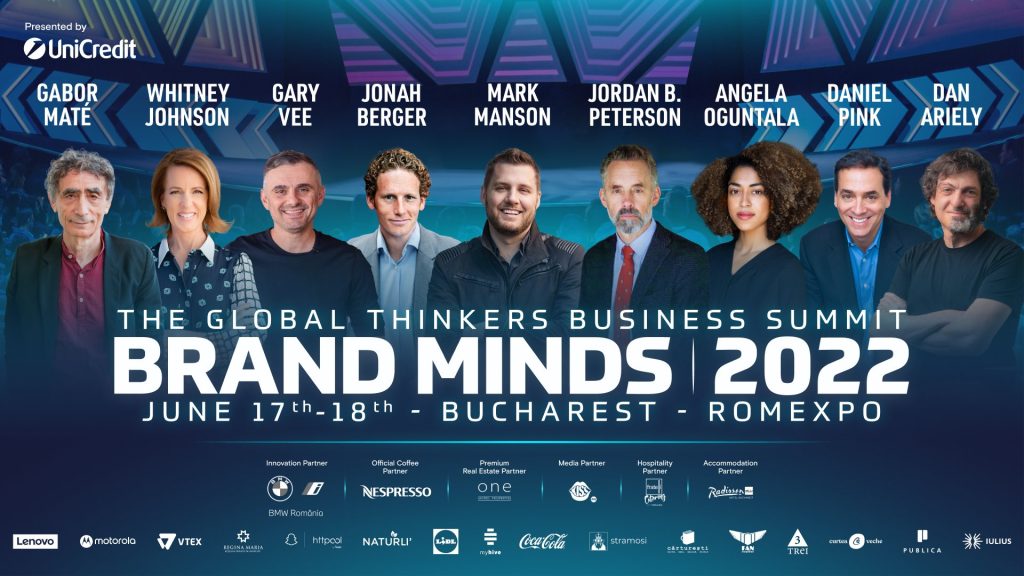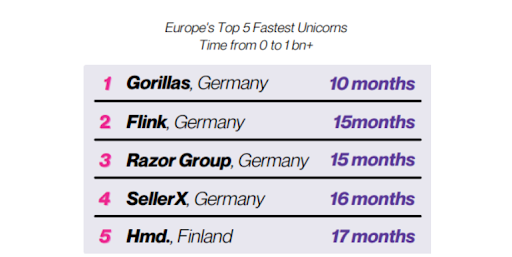This is the structure of a winning team
One of the most important tasks of top executives is to make sure, in collaboration with the head of human resources, that new talent comes into the company. Professionals whose skills, expertise, education and attitude help the company meet its business goals and carry out its mission.
These professionals don’t work in a bubble, isolated from each other. Given the highly dynamic profile of the business world over the last years, when digital disrupted entire industries from top to bottom and forced companies to adapt and reinvent themselves, employees need to collaborate and work in teams.
The structure of the team is of paramount importance. Who needs to be part of the team? Is it better to have seniors outnumbered by juniors? How long it takes for a junior to become a senior? How engaged and motivated continues to be the employee who reached the highest level of expertise?
The S learning curve is an efficient team development strategy
The S learning curve strategy is a great framework to build a winning team and a highly efficient tool for employee development. This framework is the essence of professional development for employees at every stage of their careers.
Created by prominent sociologist and communication specialist Everett Rogers, the S learning curve is the template for the innovation process. The curve was later developed by team performance expert and BRAND MINDS 2022 speaker Whitney Johnson to map out the stages of building the best team.
By applying the S learning curve model to the professional learning and development of the employee, we can place every employee in one of the following categories:
Beginners
Fast learners
Experts
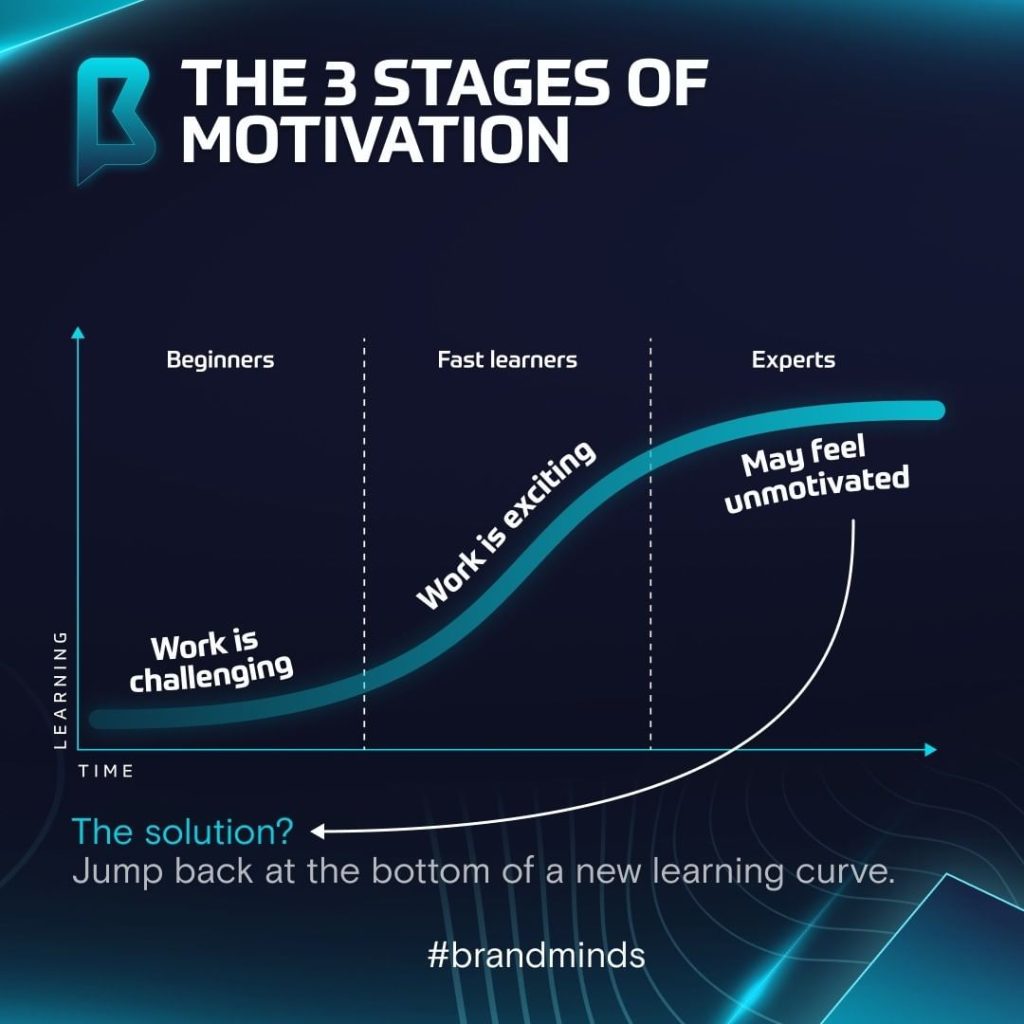
The 3 stages of employee engagement
Each employee and team member is in a different stage of the learning curve. It is the talent development specialist’s job to understand at which stage is the employee and to discover what is the next step for them and how to best help the team and the company from that place.
When the employee is at the first stage, their work is exciting and challenging. In the second stage, that of fast learners, the employee feels the work they are doing is pushing them to become better and overdeliver.
When the employee becomes an expert, the work might start to feel not as challenging and exciting as in the previous stage and it is possible for their engagement level to drop.
The solution? To go back to the first stage of the S learning curve and take on challenges of a different nature within the company, maybe in a different team or a different department – all in line with their set of skills.
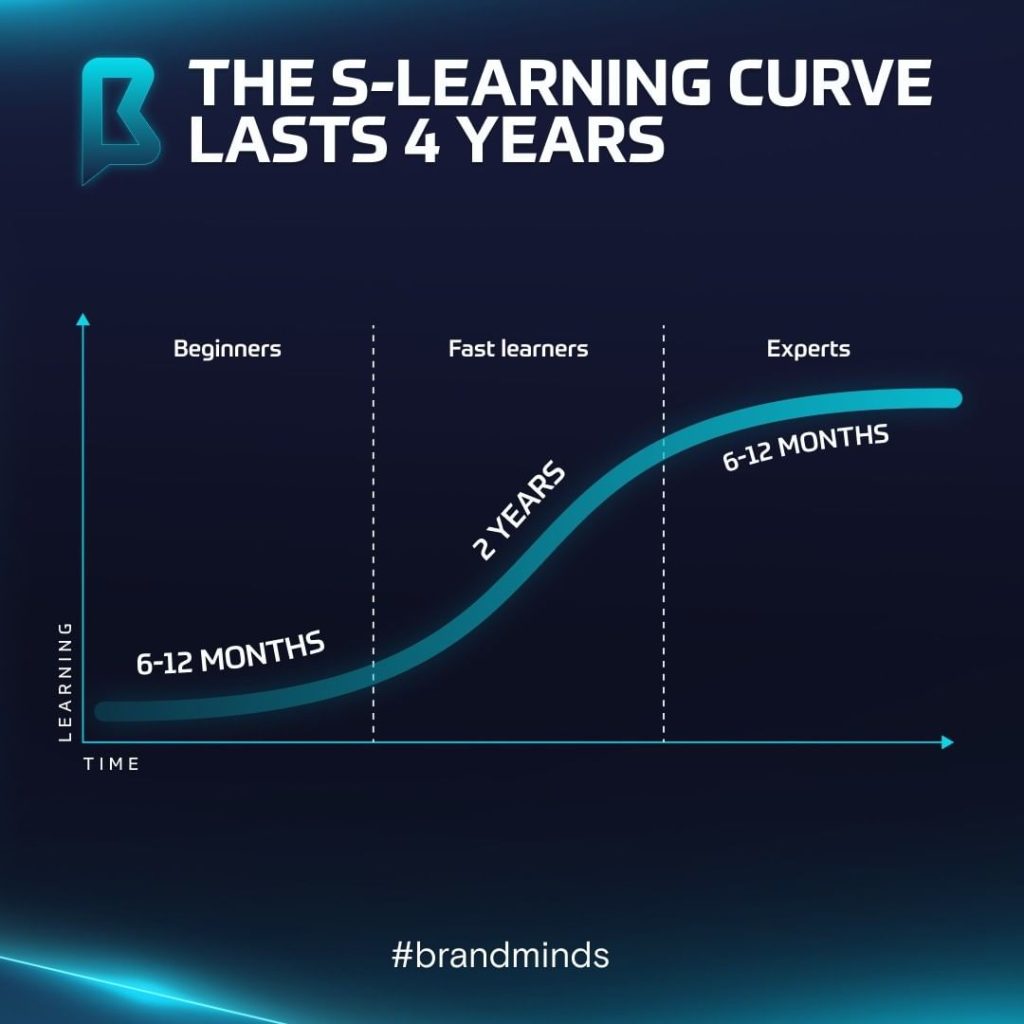
The employee goes through the S learning curve in 4 years
According to the latest research on employee development, every employee goes through the S learning curve in 4 years on average.
This is a very important and necessary piece of information for recruitment and talent development professionals. Based on this knowledge, they can create development plans for various teams through which they can maintain a high level of motivation and engagement among employees.
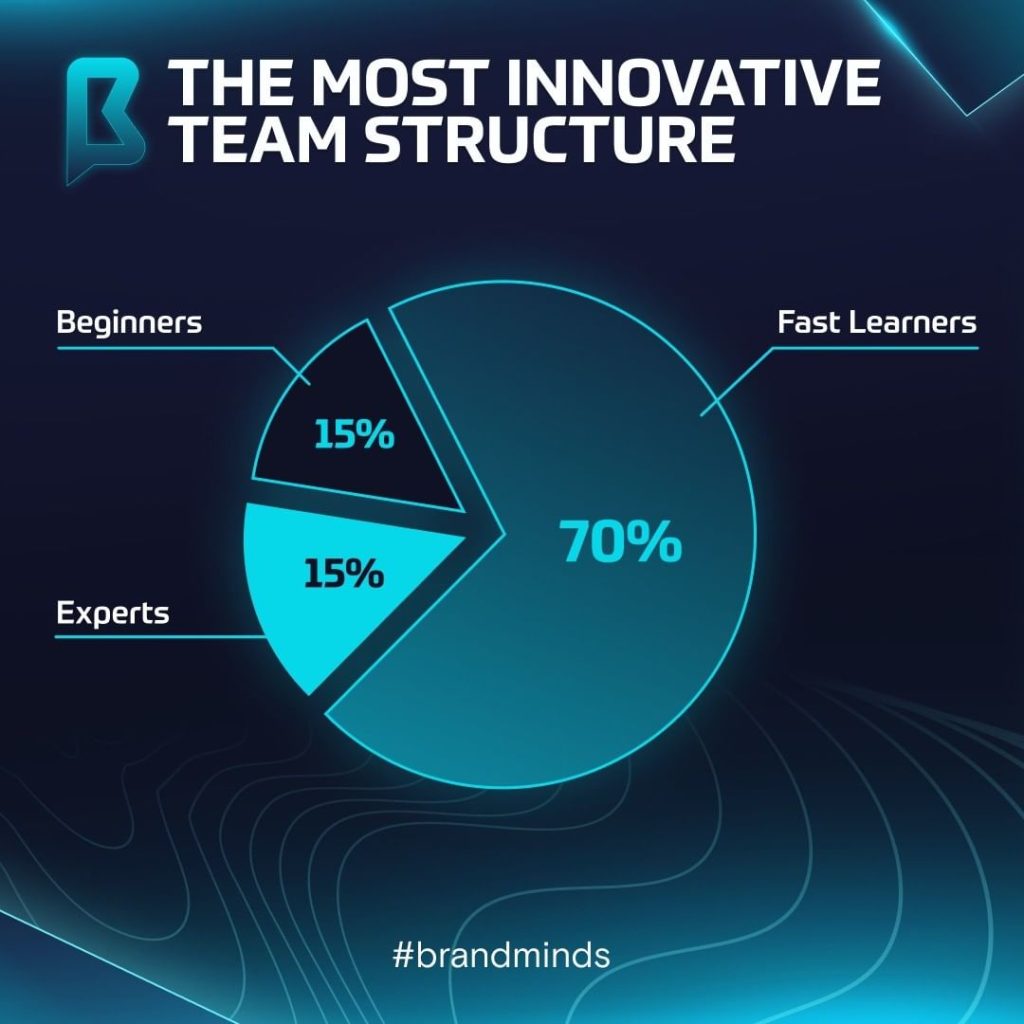
The perfect structure of the winning team: 15% beginners, 15% experts and 70% fast learners
Contrary to what you might believe, a successful team is not comprised of experts, but fast learners because they absorb every knowledge available to them to do a stellar job.
What is the reasoning for the 15%-15%-70% team structure?
The beginners are the employees who ask questions and are highly driven to learn as much as possible. With a fresh and unbiased view of their jobs and the company, these employees can highlight aspects of the business or operational processes that the other team members have missed thus creating new opportunities for change.
As far as the experts on the team are concerned, it is recommended to cap their number to 15%. They serve the team best when they have the necessary framework to help them pass on their body of knowledge.
The fast learners are the engine of the company. They have a high level of productivity, meet their goals efficiently and push themselves and the business further.
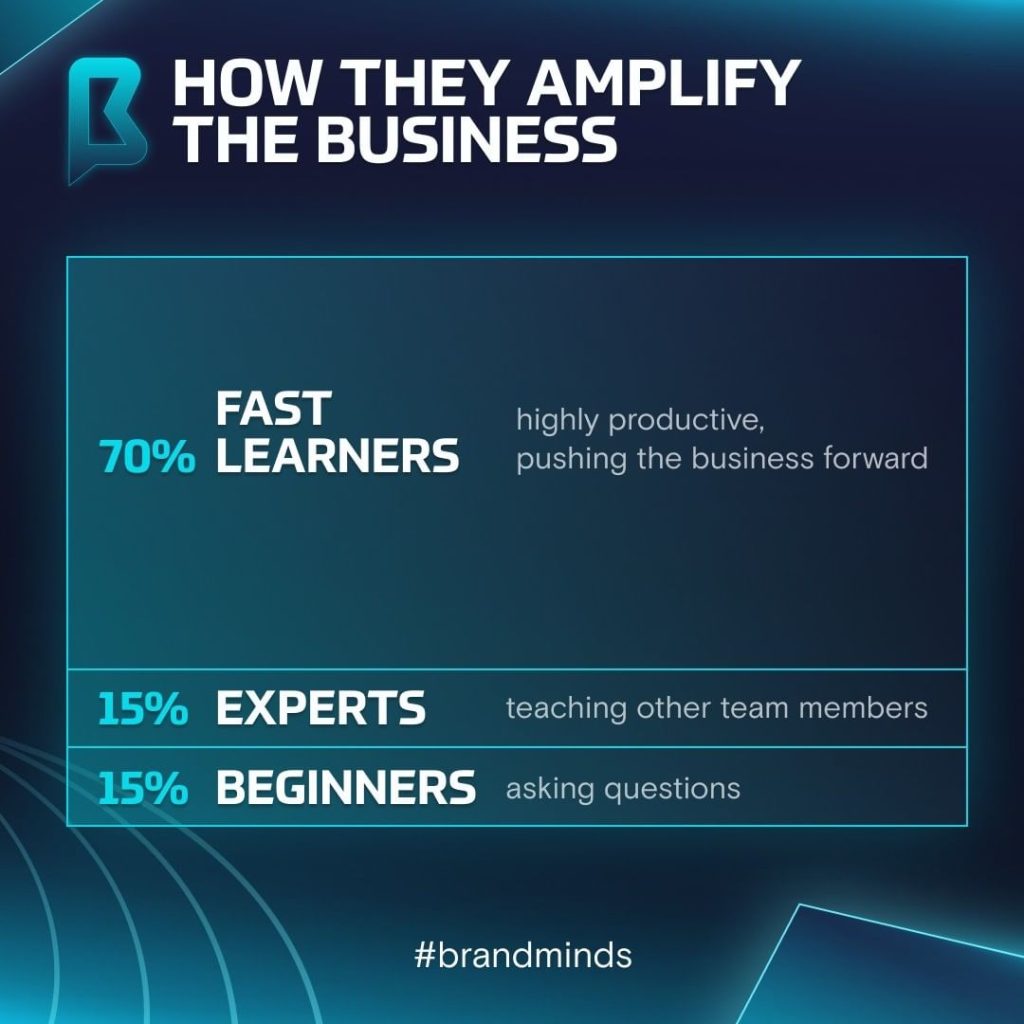
There you have it: if you want to build the best team you need to develop every member of your team. Employee development is one of the most important elements of company culture.
Do you want to protect your company from the Great Resignation or the quiet quitting movement?
Invest in your employees, and help them improve their professional skills because when they grow, your business grows.

BRAND MINDS is the best professional development event for your team. It’s like an MBA except you don’t send your employees to eight training programs over the course of a year, and they still get the expertise of eight business leaders with a combined experience of 160 years.
One of the business leaders whose expertise is focused on high-performing teams is Lynda Gratton, Future of Work Strategy Expert @London Business School.
She is an award-winning author on the future of work and the role of corporations. As the Professor of Management Practice at the London Business School, she designed the ‘Human Resource Strategy in Transforming Companies’ programme and has since led it for over 20 years. The programme is considered one of the world’s leading programmes for people and organisations.
Here are her takeaways directly from the stage at BRAND MINDS 2023:
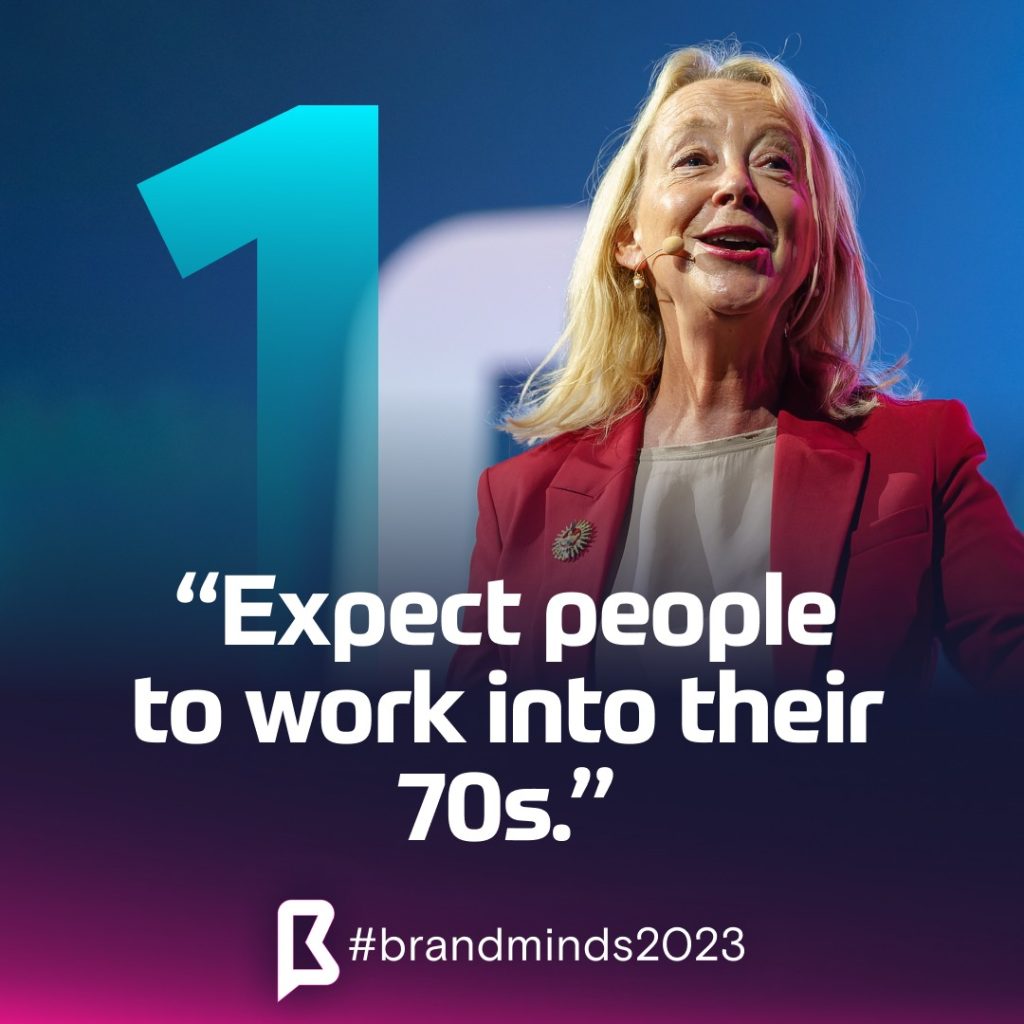

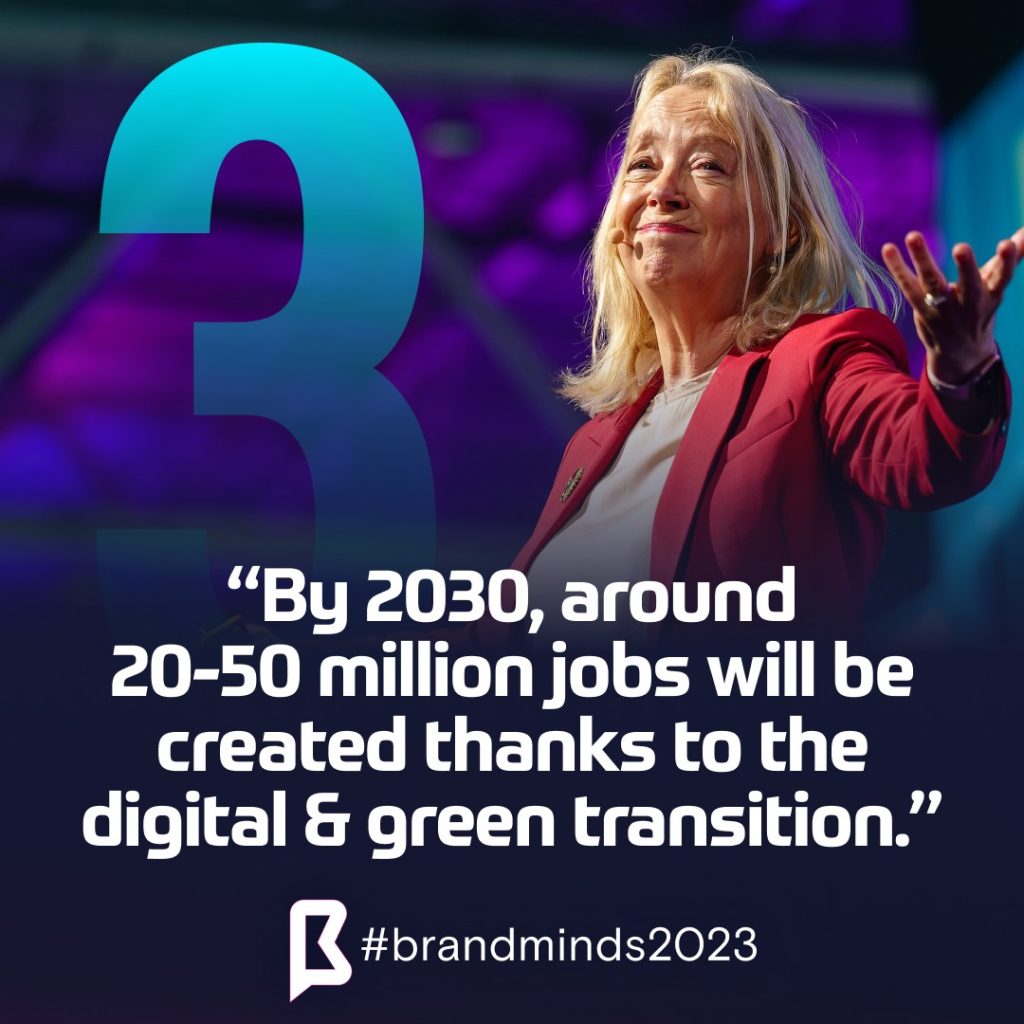
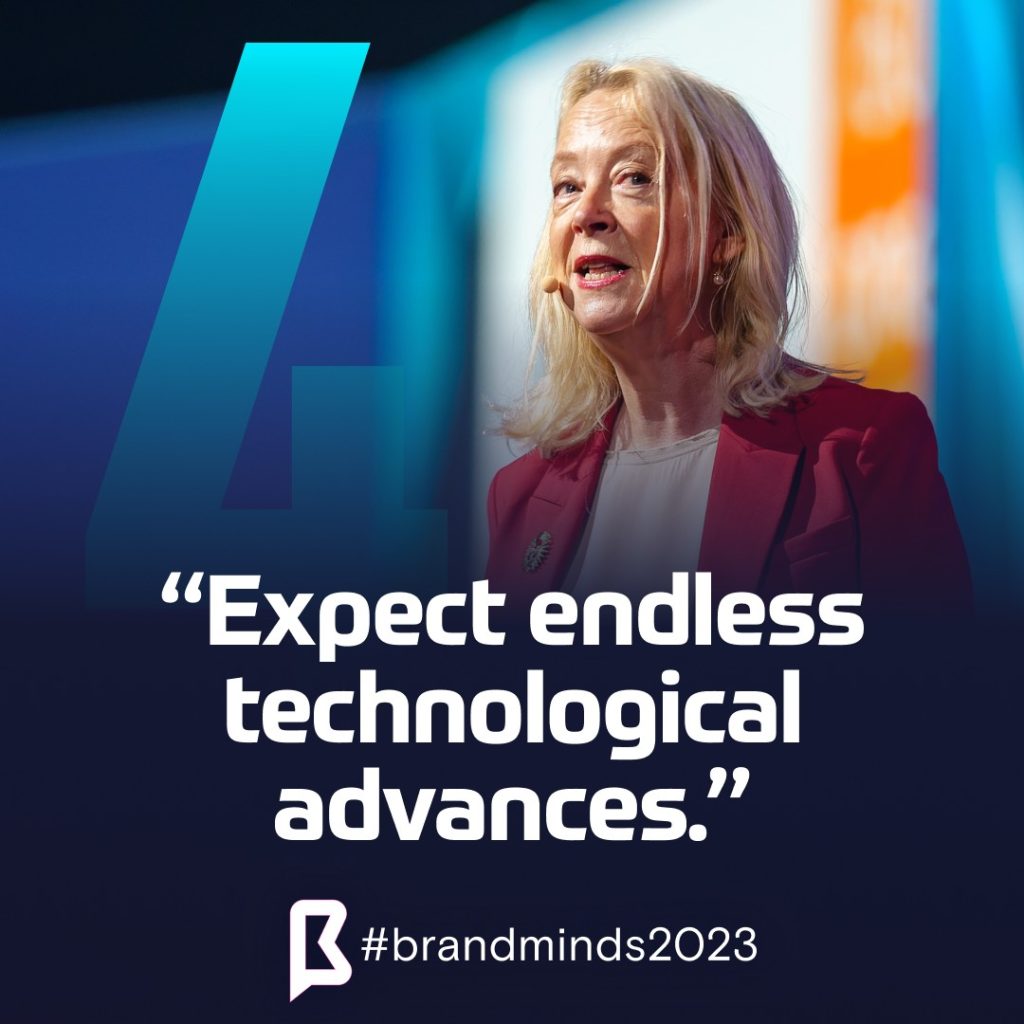
Patagonia – The Story behind the Brand
On September 14, 2022, Yvon Chouinard, the founder of outdoor apparel and gear Patagonia made the news with a unique leadership and business decision: he donated his 3 billion US dollar company to a climate change organization effectively committing his business to protect Earth.
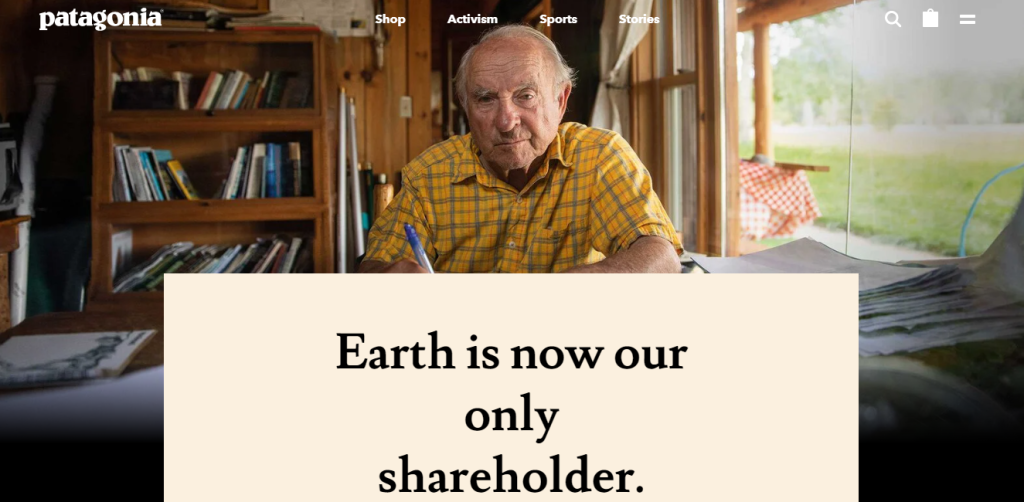
Patagonia.com’s landing page
Patagonia’s new owners are the Holdfast Collective and the Patagonia Purpose Trust.
Holdfast Collective is a not-for-profit organization; the organization receives funds to fight the environmental crisis, protect nature and biodiversity, and support thriving communities and decision-makers dedicated to building a better future for people and Earth.
The Patagonia Purpose Trust was created solely to protect the company’s values and mission. All excess profits—money the company makes after reinvesting in the business—will be distributed as a dividend to the Collective to be used for its work.
Truth be told, there were no good options available. So, we created our own.
Instead of “going public,” you could say we’re “going purpose.” Instead of extracting value from nature and transforming it into wealth for investors, we’ll use the wealth Patagonia creates to protect the source of all wealth.
Yvon Chouinard
With this decision, Yvon Chouinard has just redefined the meaning of going all-in business-wise. It’s also unprecedented: no other founder has donated their billion-dollar company to a non-profit organization no matter how strongly they supported its mission. When or if other business leaders follow his example, as he said he hoped, remains to be seen.
View this post on Instagram
Read on to discover Patagonia’s story behind the brand and how Yvon Chouinard has slowly changed the meaning of doing business.
Looking to learn about other purpose-driven companies running successful businesses? Click here and here.

PATAGONIA – The Story behind the Brand
When Yvon Chouinard became an entrepreneur, almost fifty years ago, he didn’t imagine nor wished that one day he would become a billionaire. He wanted to make outdoor clothing and gear for his mountain climbing friends and himself.
The first money he ever made as a young entrepreneur, was selling steel pitons he made himself on an old forge. Encouraged by his success, he started Chouinard Equipment with a friend. Within nine years, Yvon and his partner had redesigned and improved almost every climbing tool.
The climbing gear produced by Chouinard catered to the needs of the climbing community: it was stronger, lighter, simpler and more functional. Unfortunately, it was also damaging the rock. To protect the mountains he loved so much, he decided to replace steel with aluminium.
The aluminium chocks were an innovation so the first step to market them to the climbing community was to show the climbers how to use them through printed essays in the company’s catalogues.
The chocks were an instant success and paved the way for the next innovation: the quick-drying insulated apparel and underwear. From this point on, the company began to make significant investments in the research and development of new and innovative fabrics.
As we began to witness the extent of global warming and ecological destruction, and our own contribution to it, Patagonia committed to using our company to change the way business was done.
If we could do the right thing while making enough to pay the bills, we could influence customers and other businesses, and maybe change the system along the way.
Yvon Chouinard
Over the next decades, the company, now known as Patagonia, has grown at a fast pace but maintained the community-centred culture that was there at the beginning. Employees dressed casually, played volleyball in the sandpit at the back of the company building, ate healthy, mostly organic food at the company’s cafeteria or had lunch with their children at the on-site childcare centre, among the first in the country at that time.
When you care about your people, you care about the environment; when you care about the environment, you care about people. One nurtures the other.
It’s been nearly 50 years since we began our experiment in responsible business, and we are just getting started. If we have any hope of a thriving planet—much less a thriving business—50 years from now, it is going to take all of us doing what we can with the resources we have. This is another way we’ve found to do our part.
Yvon Chouinard
The company’s shift towards protecting the environment continued naturally in the early 70s with its first contribution: to save the Ventura river and its fish habitat from a development plan. The donation was small but it made a difference: the difference between killing and saving a natural ecosystem.

Excerpt from Patagonia’s Annual Report 2021
Yvon and his core team were inspired and began making regular donations to smaller groups working to save or restore habitats. They never donated to big NGOs acting very much like corporations; they always directed the money toward local grassroots organizations with an authentic passion for the environment.
Starting in 1985, Patagonia pledged 10% of its profit to conservation groups. They felt they weren’t bold enough so they took it one step further and committed 1% of sales, profit or not.
Entering a new decade, the company took steps to reduce the influence of its business on the environment and began using 100% organic cotton exclusively.
In 2011, they made a bold statement with their anti-consumerism Black Friday ad Don’t buy this jacket.

In 2012, Patagonia became a B-Corporation (B stands for “benefit”), a certification received by companies with an explicit social or environmental mission, and a legally binding fiduciary responsibility to take into account the interests of workers, the community and the environment as well as its shareholders. For 2022, Patagonia has been recognized as one of the Best For The World B Corps in Environment and Community (source).
In 2017, Patagonia sued President Trump following his proclamation to reduce the territory of Native American national monuments in Utah.
In 2018, the company’s mission changed to a very clear and simple statement: We’re in business to save our home planet. The company’s revenue for 2022 is estimated at 1.5 billion US dollars which goes to show that having a solid commitment to its brand-driven activism is also good for business. The company has built a strong community around
In 2020, the company launched a collection of Patagonia shorts with tags that said Vote the A**holes Out as a response to those politicians denying the reality of climate change but looking to get elected that year. It wasn’t a brand campaign, the media and the wider public found out about the message when a photo of the tag was posted on Twitter. Needless to say, the line sold out immediately and now they are a collector’s item.
Pure🔥by @patagonia. pic.twitter.com/PDCnHSqsjo
— Corey Ciorciari (@CoreyCiorciari) September 12, 2020
Now the company has taken the ultimate step toward fulfilling its brand mission: every dollar made that’s not reinvested back in the business goes to fund the work of the Holdfast Collective, namely around 100 million US dollars a year.
Patagonia is now at the stage where business equals the mission and the community. Through everything it does, the company gives a powerful voice to a community of millions worldwide and uses its resources to protect nature and secure a better future for our children.
Despite its immensity, the Earth’s resources are not infinite, and it’s clear we’ve exceeded its limits. But it’s also resilient. We can save our planet if we commit to it.
Yvon Chouinard
Top 3 tech industries attracting most funding in Europe
Top 3 global areas attracting investments: the US (620 billion US dollars), Asia (174 billion US dollars), Europe (116 billion US dollars)
2021 has been a great year for the tech industry in Europe. In terms of VC investments, Europe ranks #3 behind the US and Asia.
Nevertheless, funding to European startups showed unprecedented growth in 2021, as per Crunchbase reports, with 116 billion US dollars invested. That’s up 159% compared with the 45 billion US dollars invested in 2020.
Top 3 European countries attracting the most investments in 2021: the UK, Germany, France
With 37.8 billion US dollars in funding, the United Kingdom has attracted the most investments cementing its name as The Tech Hub of Europe. The runner-up is Germany with 19.3 billion US dollars followed by France with 12.1 billion US dollars.
Before going any further with our analysis of European tech and the industries generating the most unicorns, let’s zoom out and see the Top 3 global tech ecosystems.
Top 3 global tech ecosystems by # unicorns and value
(source Dealroom)

With a tech ecosystem valued at 16.4 trillion US dollars, the US is the undisputed leader of everything tech.
And it’s not surprising. It’s the home of the Big 5 Tech giants – Amazon, Meta, Apple, Alphabet and Microsoft – which generated a combined 1.4 trillion US dollars in revenue, in 2021.
Valued at 4.3 trillion US dollars, China’s tech ecosystem is booming.
A 2021 analysis by World Economic Forum showed that the country’s 3 main drivers for startups in tech are:
- government policies,
- the collaboration between industry and academia
- high competition nurtured by the country’s immense domestic market
The tech ecosystem in Europe is valued at 3.5 trillion US dollars.
What factors are driving the success of tech European startups?
Business consulting and analysis firm McKinsey looked at the top 1,000 European start-ups founded after 2000 in 33 countries and came up with a few interesting conclusions shared in their 2021 report Winning formula: How Europe’s top tech start-ups get it right.
Here are the main takeaways:
- The most successful companies have taken one of 4 distinct paths: network, scale, product, or deep tech;
- Reaching unicorn status requires on average 100 million EURO to 200 million EURO in funding;
- 70% to 80% of the companies that receive the necessary funding become unicorns within ten years of founding;
- The network path requires winning local markets one by one and not trying to grow globally in one fell swoop;
- Scale players need to focus on building strong commercial capabilities;
- Product startups need to prioritize a compelling product and narrow use case initially
- For deep-tech startups, attracting and retaining the best talent is essential.
Top European tech ecosystems valued at 100+ billion dollars
(source Dealroom)
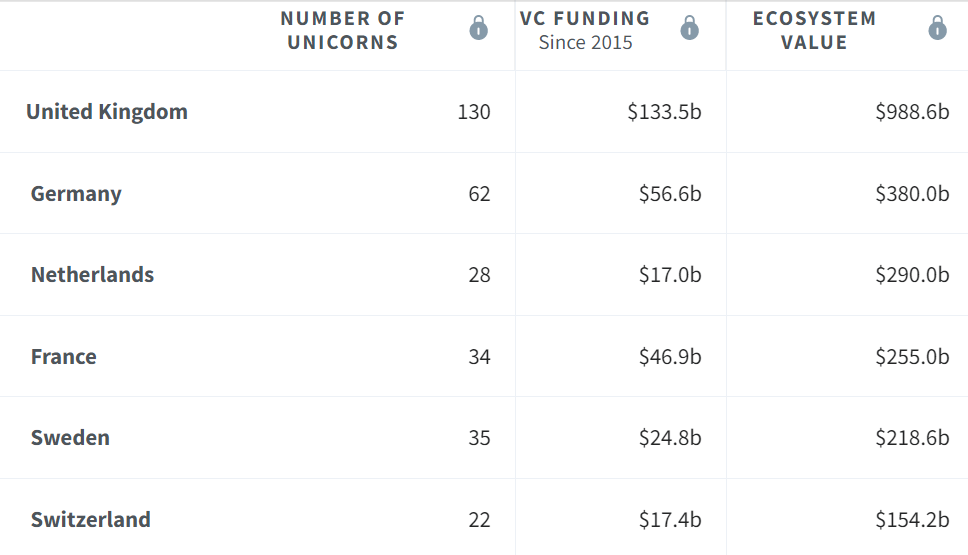
Top 3 tech industries in Europe by ecosystem value
The three tech industries receiving billions of dollars in funding in Europe are Fintech, Enterprise Software and Health.
In the graph below, you can see how much investment the European countries with 100+ billion UD dollars tech ecosystems pour into startups developing solutions in these industries.
Fintech is the #1 industry attracting the majority of funding money in the UK.
Developing health solutions is prioritized in Switzerland, Germany, the Netherlands, France and Sweden.
Enterprise Software comes in second in Switzerland and France.
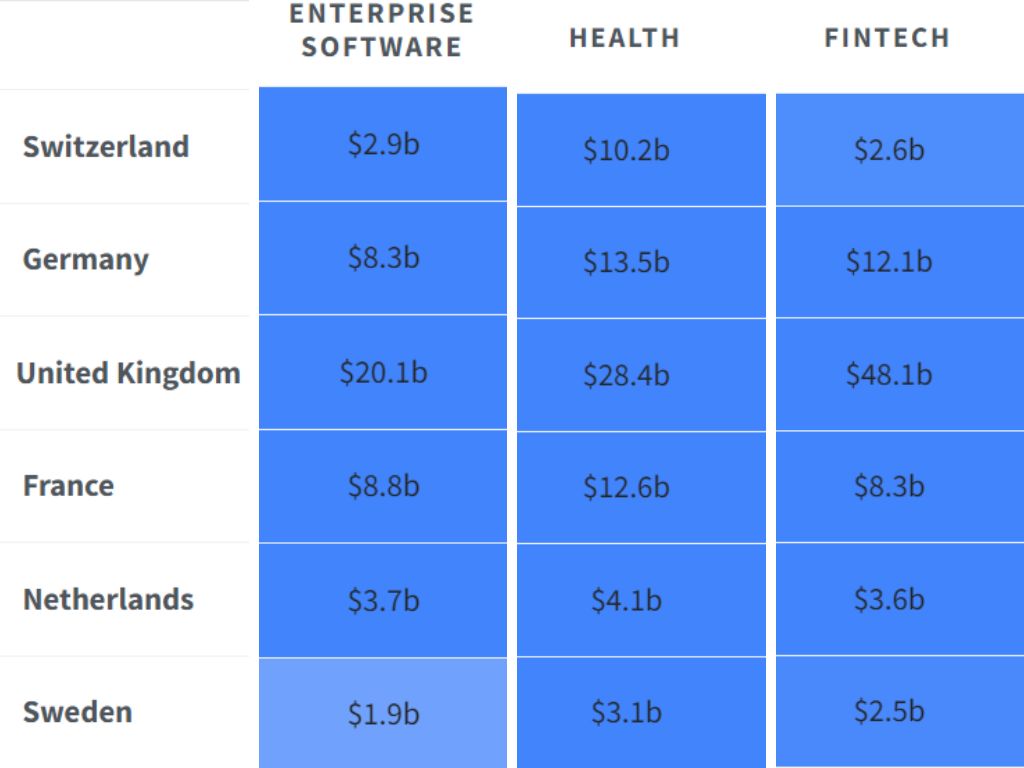
The UK’s new 2022 tech unicorns
The UK continues to be the #1 tech hub in Europe, in 2022, home to 131 tech unicorns and 228 future tech unicorns to date.
Recent reports estimate a $1 trillion valuation for the U.K.’s startup and scaleup ecosystem, with fintech leading the way as the industry attracts the most money from VCs.
Tech ecosystem value in European countries
(source Dealroom)
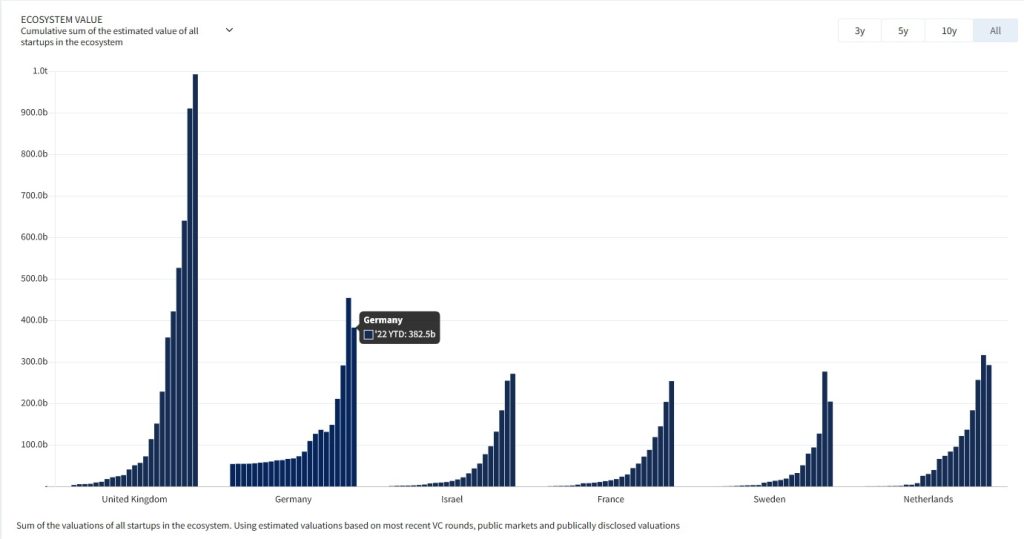
THE UK’S TECH ECOSYSTEM – STATISTICS (source: Dealroom)
- Top 3 industries by value: Fintech (48.1 billion US dollars), Health (28.6 billion US dollars), Enterprise Software (20.1 billion US dollars)
- 607.000 employees
- 133.6 billion US dollars in VC funding since 2015
- 15.000 funding rounds since 2015
- 40.000 startups
- 23.000 startups founded in the last 10 years
THE UK’S NEW 2022 TECH UNICORNS

5ire – The world’s first sustainable blockchain
Current valuation: 1.5 billion US dollars
Total funding: 121 million US dollars
5ire investors: SRAM & MRAM Group, Oracle Investment Management, Alphabit Fund, Marshland Capital, Moonrock Capital, Launchpool, Magnus Capital, Sanctum Global Ventures
Tech startup 5ire is just one year old and already a unicorn! Its co-founders are Pratik Gauri, Prateek Dwivedi and Vilma Mattila.
In a recent interview, 5ire CEO Pratik Gauri said that their primary goal starting out was to “impact a billion people positively.”
How are they going to achieve that?
By building a scalable decentralized, open-source blockchain for Impact & SDG-related development, to help accelerate the United Nations 2030 Agenda for Sustainable Development.
“Our goal is to work hard to provide finance platforms that could potentially revolutionize access to capital and unlock potential for new investors in projects that address environmental challenges”, says the 5ire team.
What is 5ire’s current challenge and what is the company doing to overcome it?
Here’s what 5ire co-founder & CEO Pratik Gauri answered:

Founder & CEO Pratik Gauri
Human Capital is a big challenge in the web3 / blockchain space. Since we are using rust to develop a sustainable blockchain with a unique consensus called Proof Of Benefit, it’s been a challenge to find rust developers.
To overcome this, we’ve started a 5ire digital university to train developers on rust/substrate and hire them in-house.

Multiverse – The UK’s first-ever EdTech unicorn
Current valuation: 1.7 billion US dollars
Total funding: 414 million US dollars
Multiverse investors: Lightspeed Venture Partners, Index Ventures, Salesforce Ventures, General Catalyst Partners, D1 Capital Partners and others.
Tech unicorn Multiverse provides high-quality apprenticeship programmes that combine work, training and community. Its mission is to create a diverse group of future leaders; its focus is on developing new skills and competencies for the digital economy.
Multiverse was founded by Euan Blair in 2016 and has grown across the UK, training over 5,000 apprentices in partnership with more than 200 of the world’s best employers.
Multiverse helped many industry leaders close the skills gaps within their workforce and grow retention including global leader in financial services Morgan Stanley, Big Four accounting organization KPMG and Global Investment Bank and Financial Services Citi.
In June 2022, the EdTech unicorn announced the closing of $220m Series D funding and highlighted the following great results:
- Its software engineering program has seen a 260% increase in enrolments while maintaining a completion rate of 85%;
- The number of partners has grown by 105%;
- Since 2020, Multiverse has grown 9x in size;
- The company now trains professional apprentices with over 500 organizations globally, including Verizon, Cisco, Visa and others;
- Of the apprentices they have placed, 56% are people of color, more than half are women, and 34% hail from economically underserved communities;
- 68% of their apprentices are promoted either during their program or at its conclusion;
- 90% find permanent employment, either at their employer or within their industry.
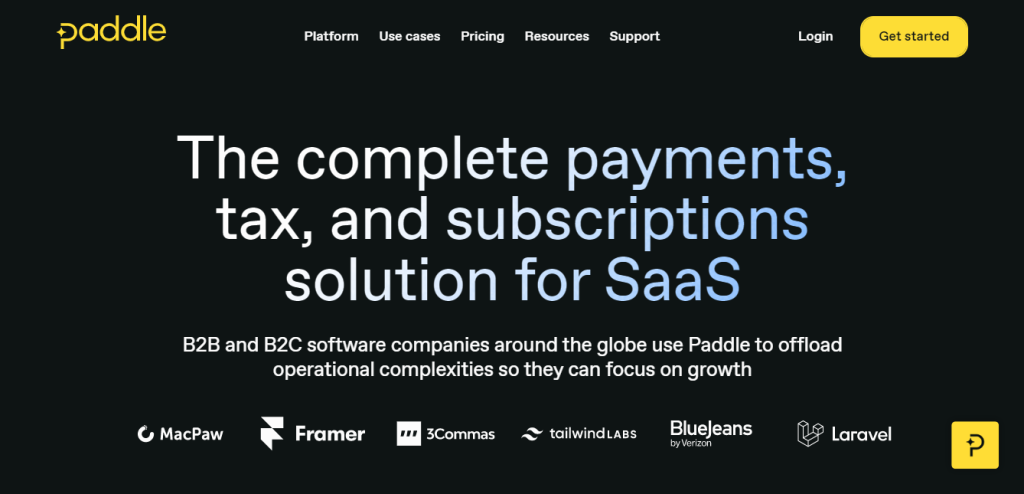
Paddle – The complete payments infrastructure provider for SaaS companies
Current valuation: 1.4 billion US dollars
Total funding: 291 million US dollars
Paddle investors: Silicon Valley Bank, Notion Capital, Kindred Capital, Business Growth Fund, 83North and others.
Paddle offers an all-in-one payment solution to SaaS companies looking to permanently offload the burden of managing payments and the associated liabilities.
The tech unicorn is a software expert providing SaaS businesses with Merchant of record (MoR) services allowing them to grow more quickly (learn about MoR).
Founded in 2012 by Christian Owens and Harrison Rose, Paddle has over 3000 customers and 350 employees in 17 countries. The tech unicorn has marked its ten-year anniversary with the acquisition of ProfitWell, the leading provider of subscription metrics and retention software.
Entering the second decade of its existence, curious minds might ask: Does it get any easier?
Paddle CEO Christian Owens answers: “It doesn’t get easier, the problems just change”.
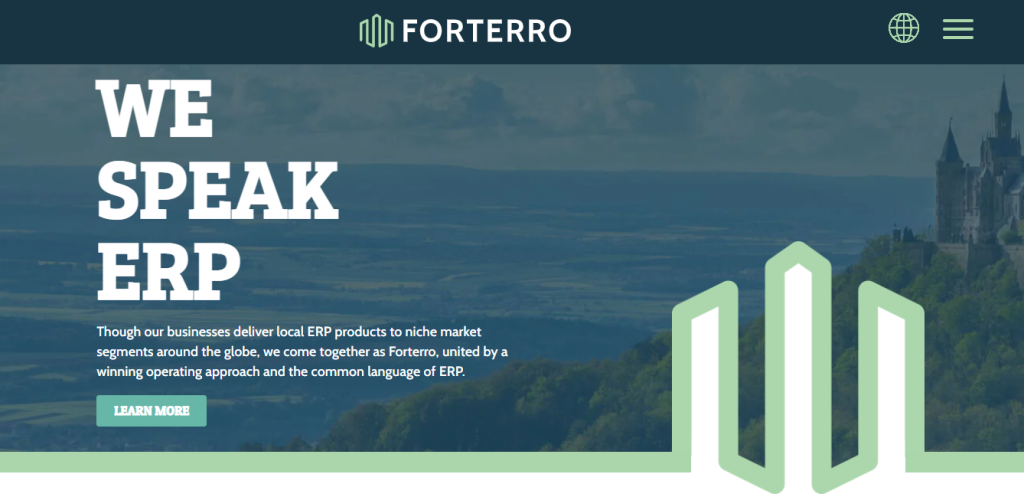
Forterro – Group of ERP software and services companies serving small to midmarket companies around the globe
Current valuation: 1.1 billion US dollars
Total funding: N/A (Battery Ventures acquired Forterro for 1b euros in 2022)
Forterro investors: Battery Ventures
With a European portfolio of specialised ERP (enterprise resource planning) software products and a global ecosystem of IT solutions and services, Forterro is a partner to more than 10,000 midmarket manufacturing and production companies.
Forterro operates product companies headquartered in Germany, France, Sweden, Switzerland, Poland, and the UK, as well as regional service hubs and development centers around the world.
In July 2022, Forterro announced the acquisition of Wise Software, a provider of ERP software solutions for industrial companies with retail, wholesale, eCommerce, and distribution requirements with 30 years in the UK market.
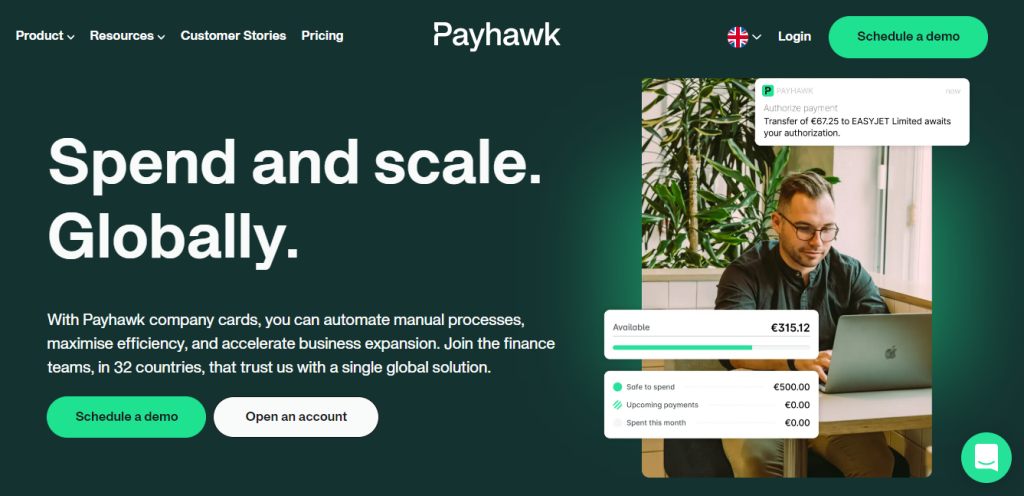
Payhawk – Credit cards, payments, expenses and cash combined into one integrated platform
Current valuation: 1 billion US dollars
Total funding: 236 million US dollars
Payhawk investors: Greenoaks Capital Partners, Lightspeed Venture Partners, Endeavor Catalyst, HubSpot Ventures, Earlybird Digital East Fund and others.
Fintech Payhawk offers all-in-one financial software to control company spending and save money. A report from the tech unicorn shows that scale-ups typically save up to 8,417 euros/month, SMBs, 1,015 euros and enterprises, 20,792 euros.
With Payhawk, small businesses manage, control and automate tedious administrative tasks, scale-ups keep spending under control and are encouraged and supported to undertake international expansion in more than 30 countries and enterprises transition to a paperless digital environment.
The UK fintech unicorn was founded in 2018 by Hristo Borisov, Konstantin Djengozov and Boyko Karadzhov. Their aspiration is “to become the world’s biggest bank without holding a single dollar”.
Their vision of the future is a world where “businesses can discover, manage and use multiple payment instruments (debit cards, credit cards, bank account etc.) powered by a single experience regardless of where money is kept.”
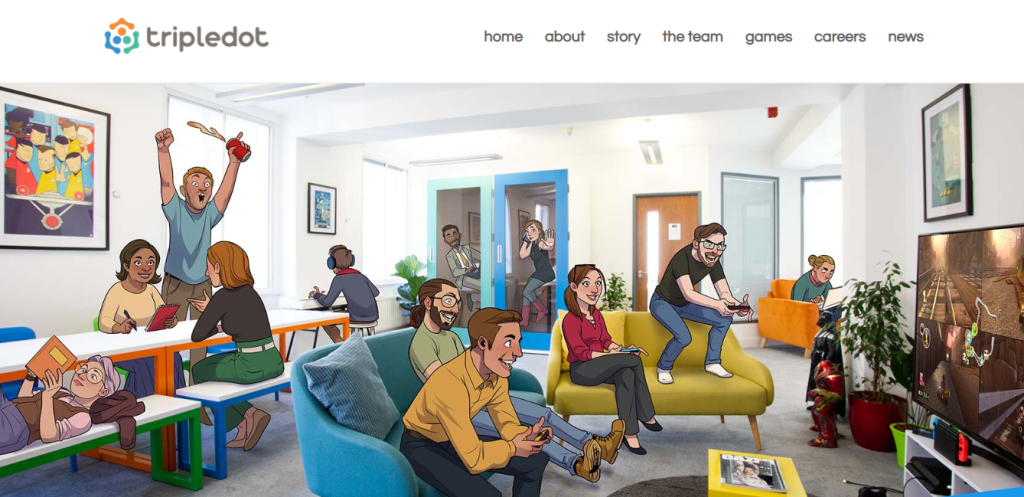
Tripledot Studios – Independent mobile game developer
Current valuation: 1.4 billion US dollars
Total funding: 202 million US dollars
Tripledot Studios investors: Velo Partners, Eldridge, Access Industries, The Twenty Minute VC (20VC) and Lightspeed Venture Partners.
Tripledot Studios is a fast-growing studio, led by a team of industry veterans from some of the biggest names in mobile games.
The tech unicorn was founded in 2017 by Akin Babayigit, Eyal Chameides and Lior Shiff. Their goal is to create fun, successful games for everyday gamers. The team’s guiding belief is that “when we love what we do, what we do will be loved by others. Together, we create games we know our players will enjoy, from easy-to-pick-up casual games to groundbreaking innovative ones.”
In a profile article in Forbes, the team shared that the company did $200 million in revenue last year on an estimated profit of around $30 million with over 30 million monthly users enjoying their games. Tripledot’s biggest hit is Woodoku, a combination of Tetris and sudoku. It launched in 2020 and has since been downloaded 100 million times.
I asked Tripledot Studios COO Akin Babayigit what is the company’s biggest challenge today and what is the team doing to address it.

Co-Founder & COO Akin Babayigit
Tripledot has been very fortunate to be growing leaps and bounds over the past few years, in an industry as highly competitive as mobile gaming.
As a growing organisation, our biggest challenge is to continue hiring the best & the brightest minds to become Tripledotters.
We saw in our previous experiences that growing organisations may tend to lower the quality bar for new hires as the pressures of growing become more pronounced. We don’t want to sacrifice our track record of hiring the best and the brightest minds, so our hiring bar remains exceptionally high. That probably is our biggest challenge at the moment.

Accelerant – Insurtech Unicorn with an Excellent (A) credit rating
Current valuation: 2 billion US dollars
Total funding: 190 million US dollars
Accelerant investors: MS&AD Ventures, Altamont Capital Partners and Eldridge.
Accelerant is a data-driven, technology-fueled insurtech that empowers underwriters with superior risk exchange, advanced data analytics, and long-term capacity commitments.
The company’s technology platform, InsightFull™, allows customers to spot small issues early before they become big problems.
Accelerant was founded by insurance industry veterans Jeff Radke and Chris Lee-Smith. They are joined by a team of professionals who understand the challenges of dealing with conventional carriers. Accelerant is Property and Casualty focused with a portfolio containing Hospitality, Arts & Entertainment, InsurTech, Habitational, Construction, Retail, Mercantile, Service, Trade, Surety and Warranty.
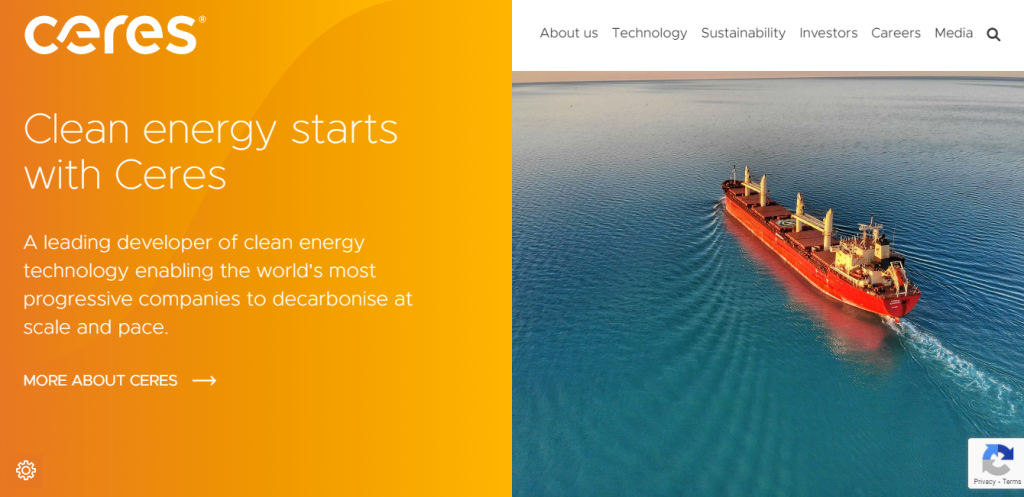
Ceres Power Holdings – World-leading developer of low-cost, next-generation fuel cell technology that creates a real-world energy solution
Current valuation: 1.2 billion US dollars
Total funding: 252 million US dollars (per Crunchbase)
Ceres Power Holdings investors: University of Bristol Enterprise Fund, Imperial College London, Parkwalk Advisors, Advanced Propulsion Centre UK, Investec and Berenberg (Germany).
Ceres Power Holdings is a clean tech unicorn, one of the leading developers of fuel cell technology in the UK. With 21 years of experience developing green technology, the company’s ultimate purpose is to help sustain a clean, green planet by ensuring there is clean energy everywhere in the world.
In recent news, Ceres has partnered with Shell to deliver a megawatt-scale electrolyser demonstrator for the production of low-cost, high-efficiency green hydrogen.
Ceres’ solid oxide fuel cell (SOFC) technology shows an essential role in significantly reducing CO2 emissions.
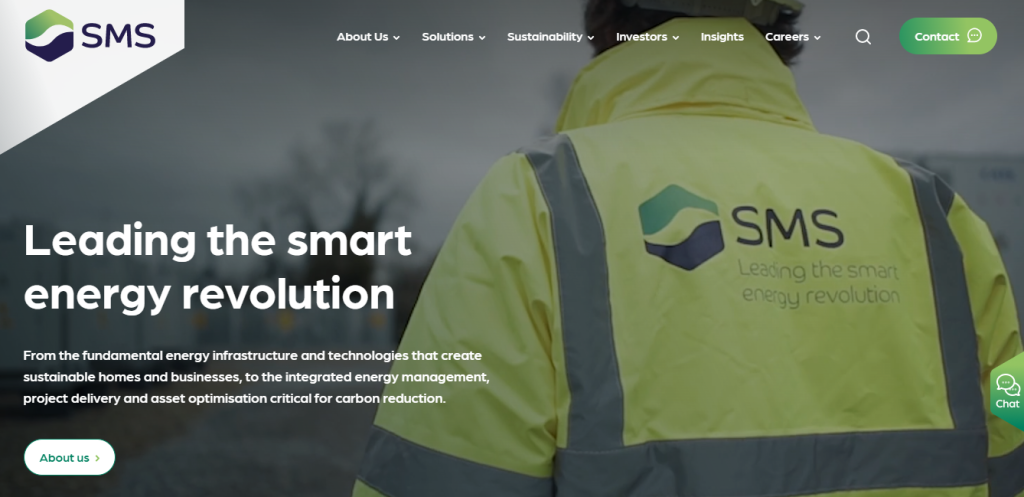
Smart Metering Systems – Provider of multi-utility infrastructure connections and meter asset management solutions
Current valuation: 1.6 billion US dollars
Total funding: N/A
Smart Metering Systems investors: N/A
Smart Metering Systems is working closely with private and public sector partners to decarbonise the UK economy by 2050.
They are a fully integrated energy infrastructure company which owns, installs, and manages carbon reduction (CaRe) assets, including smart meters, battery energy storage systems (BESS), and EV chargepoints.
Smart Metering Systems use its technology expertise, asset funding capability, and deep engineering skills to provide sustainable energy solutions for customers.
XR creator Dominik Hackl: I developed Magic Keys to bring more joy to people
For his performance in the holocaust drama The Pianist, leading actor Adrien Brody won an Academy Award. A method actor, Adrien went to great lengths to portray his character, the Jewish Polish pianist who loses contact with his family during the Second World War and the struggles he faces to survive. To get into his character’s mindset, he lost 30 pounds in weight, sold his home and car, broke up with his girlfriend and practised the piano for four hours a day until he could master passages from compositions by Chopin.
Adrien Brody was 29 when he learned to play the piano. This goes to show that you can learn to play the piano at any age, even as an adult! It’s true that it’s too late to become a concert pianist, but if what you’re looking for is having fun playing music, there’s no better time than today.
If you’re reluctant to take up playing the piano because of the steep learning curve (you know: learning the notes, the music terms and so on), the Magic Keys app is the perfect solution.
Magic Keys is an extended reality app that helps you learn to play the piano in a new and easy way (you can learn the notes later).
The app was developed by Dominik Hackl, a passionate game developer with a strong interest in Virtual and Augmented Reality.
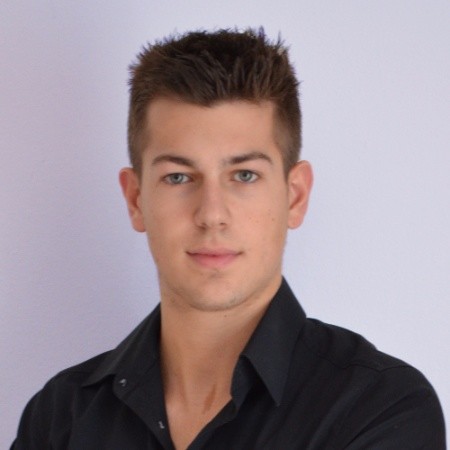
Magic Keys app creator Dominik Hackl
He’s also a pianist so he understands the needs of grown-ups who regret stopping piano lessons when they were kids or people who have never taken lessons but wished they had – like me.
For the people in either category, learning to play the piano is a dream come true (Check out the comments to his LinkedIn announcement).
In the interview below, Dominik answered a few questions on Magic Keys, the future of extended reality, what he would do if he were Mark Zuckerberg and the tech that makes his life easier as a creator.
Enjoy!
BRAND MINDS. We’ve seen VR applications in many industries: healthcare, education, and entertainment among the most prominent. Why did you choose piano learning?
DOMINIK HACKL. I am a passionate pianist myself and I’ve been playing the piano since the age of 8.
So when I first got into VR/AR development I immediately thought of this idea and knew that the piano and AR would be a perfect match.
Also, I know many people who would love to learn the piano but are afraid of the steep learning curve. With the app, my goal is to make the instrument more accessible and bring more people to enjoy it.
BM. What is the future of mixed reality applications in your opinion?
DH. There are many areas which can seriously benefit from Mixed Reality applications. But in my opinion, there is currently a little too much hype around the whole metaverse concept.
We should first focus on creating solid applications that can actually be achieved with the current state of hardware rather than already fantasizing too much about transforming all aspects of our lives into some kind of metaverse.
These discussions are definitely important but I think there is too little emphasis on what’s currently possible.
BM. You are the creator of a number of games for Windows and Android. Is game development experience mandatory for developing projects in Virtual and Augmented Reality?
DH. I would not say it is mandatory but there are certainly a lot of overlaps. Both, (3D) games and VR/AR applications are interactive 3D experiences, so topics like 3D math, shaders and rendering pipelines apply pretty much in the same way for these disciplines.
And of course, nowadays both will usually be built on one of the big game engines, Unity or Unreal.
BM. I would like to become a mixed reality creator, where should I begin?
DH. As mentioned above, most VR/AR apps are built on a general-purpose game engine: Unity and Unreal Engine are the major players. So, I would definitely start by learning one of the engines.
Unity would be my number one choice because it’s slightly more general-purpose and tends to have earlier support for new hardware while Unreal is more tailor-made for games. Then a good level of programming is also required since all engines rely on scripting to create the behaviours for your app.
For the major engines (and their scripting) there are plenty of tutorials and guides online, so YouTube is probably a good place to start.
BM. Here’s a short imagination exercise: you have replaced Mark Zuckerberg at the helm of Meta, what is your first project? Remember, your budget for special projects is at least ten billion dollars, the amount of money the company has invested in developing the Metaverse.
DH. First off, I’m really glad I don’t have to replace him in his position 🙂
But if so, I would probably put as many resources as possible into hardware development and research since this is currently the greatest bottleneck (kind of what they are actually doing, I guess).
I would also try to clean their image as an untrustworthy data mining company by advocating for open standards when it comes to the metaverse and future development in Extended Reality (XR).
BM. What’s one myth about VR, AR or mixed reality that we need to stop believing in?
DH. That it will completely replace physical reality within the next decades.
I am really optimistic about the use cases for XR and I can’t think of any reason why we would want to replace the great aspects of our reality with a virtual one.
There are many obvious benefits of XR but then there are also obvious benefits of physical presence. Just because something can be done from a technological point of view, doesn’t mean it makes sense to do it.
BM. What tool is making your life easy as a creator?
DH. The Quest’s Oculus Link feature is still one of the best things they have done. Plugging your Quest into your PC to effectively make it a PC VR headset works just so seamlessly and it especially is a huge time saver for developing and iterating.
BM. What book are you reading right now?
DH. “Blood, Sweat and Pixels” by Jason Schreier. It tells the behind-the-scenes development stories of several famous video games.
Reading it makes you appreciate even more what an incredible miracle – from a technical, creative and business perspective – it is that any of these games are being created and finished.
BM. What app do you use daily?
DH. YouTube is by far my most used app/website. I definitely use it daily for work and for entertainment.
In return, I am almost completely abstaining from other social media apps and I don’t spend much time on my smartphone in general.
Germany is the country with the fastest-growing tech unicorns in Europe
According to the 2022 European Unicorn Soonicorn Report by international tech M&A firm, investor and venture builder i5invest & i5growth, Germany is growing 4 of Europe’s Top 5 Fastest Unicorns.
Gorillas and Flink are groceries delivery apps valued at 3.1 billion US dollars (with 2.6 billion US dollars in revenue) and 5 billion US dollars respectively. Based in Germany, both tech unicorns are fighting for dominion over the European rapid-delivery market boasting a 10-minute delivery from micro warehouses in Germany, France, the UK, Denmark, Spain, Austria and Netherlands.
Razor Group acquires and scales promising e-commerce brands into next-generation household names. The tech unicorn is valued at 1 billion US dollars and has over 200 brands in its portfolio and over 1 million customers. The companies Razor Group acquires must meet a few requirements including EBITDA of at least 250,000 EURO.
SellerX is also acquiring companies and is valued at 1 billion US dollars. The difference between SellerX and Razor Group is that the first is focused on buying Amazon small businesses and has a smaller number of brands acquired (40+).
What you need to know about Germany
With a tech startup ecosystem of 384 billion US dollars, Germany ranks second behind the UK with 989.4 billion US dollars.
The ecosystem value of the UK, Germany, France, Israel, Sweden and Netherlands
(source Dealroom)
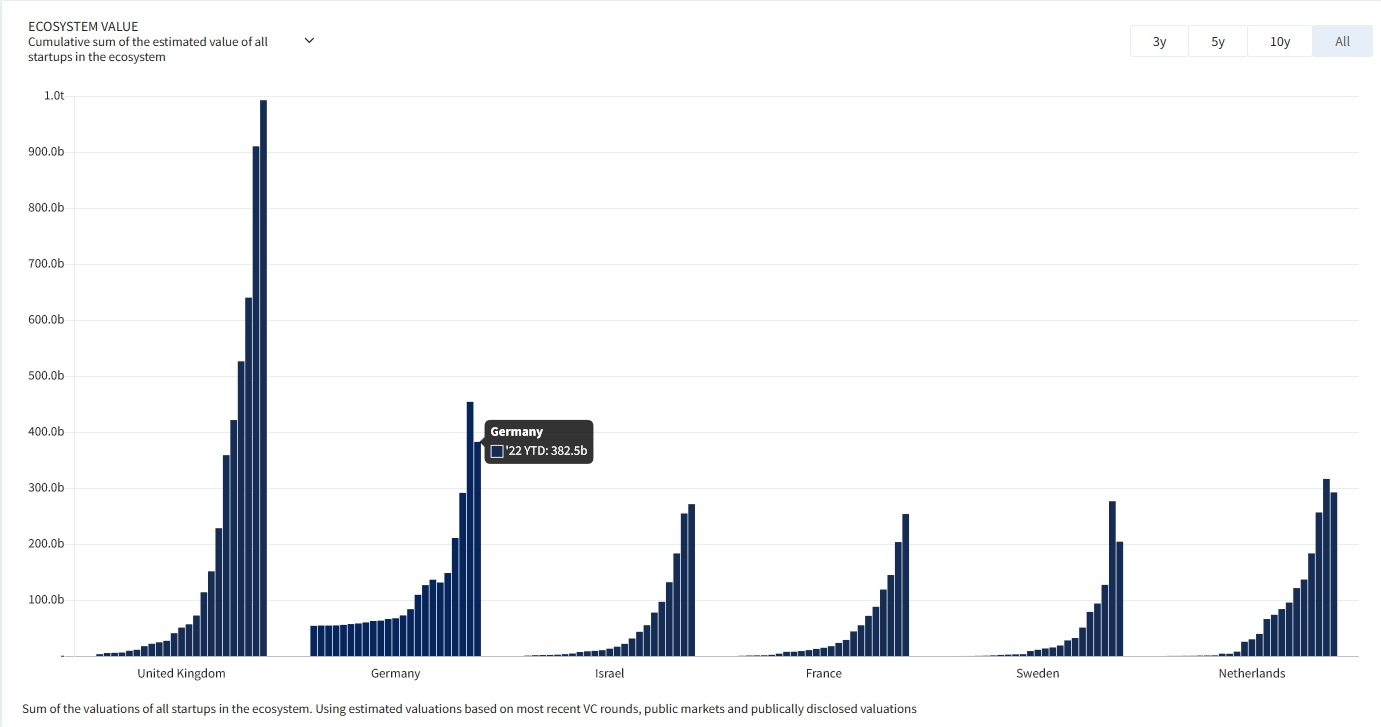
Over the last 20 months, Germany has invested 6 billion US dollars in Fintech making it the third country in Europe with the biggest investments in startups developing financial technology.
Top 3 European countries by amount invested in Fintech
(source Dealroom)
United Kingdom
5.2 billion US dollars (2020)
15.2 billion US dollars (2021)
9.3 billion US dollars (2022 to date)
France
777 million US dollars (2020)
2.6 billion US dollars (2021)
2.5 billion US dollars (2022 to date)
Germany
967 million US dollars (2020)
4.2 billion US dollars (2021),
1.8 billion US dollars (2022 to date)
The leading venture capital firms by portfolio size in Germany are High-Tech Grunderfonds, Global Founders Capital, HV Capital, Earlybird Venture Capital and Point Nine.
They are primarily focused on investing in European technology innovations and have participated in deals totalling 24.5 billion US dollars.
Top 5 German tech VC firms by portfolio size
(source Dealroom)
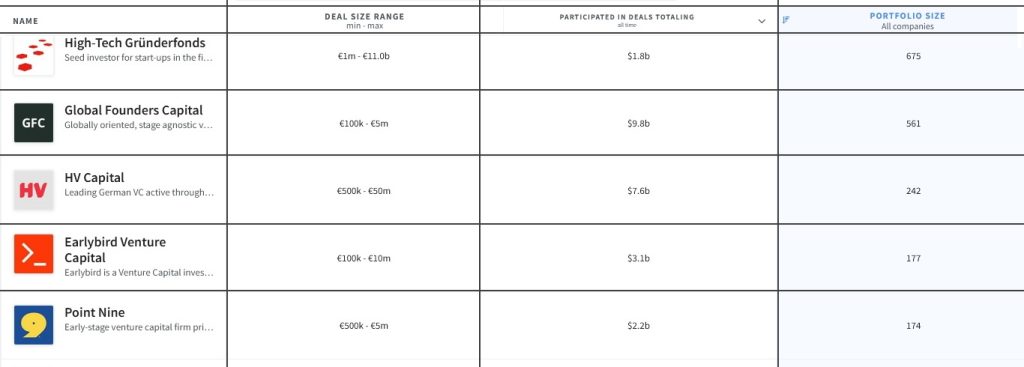
High-Tech Grunderfonds has invested in Mister Spex and commercetools, two global and EMEA unicorns.
Global Founders Capital has invested in various industry leaders including Meta, Canva, Slack, Revolut and Zalando.
HV Capital has a number of future unicorns in its portfolio like IMMO Capital, Europe’s first technology-led residential real estate platform and CoachHub, a leading global talent development platform.
Earlybird Venture Capital supports fast-growing unicorns like Aiven, an information technology company and N26Group, the bank account that can be managed entirely from a smartphone.
Point Nine has investments in 16 billion dollar Delivery Hero and 9 billion US dollars cloud-based customer service platform Zendesk.
The Germany-based startup to watch in Fintech
Based on fundraising timeline, growth indicators, founding team, and other factors
(source Dealroom)

With a whopping growth of 180% growth over the last 12 months, Advanced Blockchain invests in, innovates, and incubates blockchain and Web3 solutions on a global scale. The company deploys extensive investment, development, research, and business resources toward projects in order to generate long-term value for the industry.
Key facts about Germany to talk to your team about
- Tech ecosystem value: 384 billion US dollars
- Has invested 6 billion US dollars in Fintech over the last 10 months
- Most valuable tech unicorns and the industries they are operating in:
N26Group: 9 billion US dollars, Finance
Contentful: 3 billion US dollars, Enterprise Software
BioNTech: 24.6 billion US dollars, Health
Volocopter: 1.7 billion US dollars, Robotics
Delivery Hero: 16.6 billion US dollars, Food
Auto1Group: 12.9 billion US dollars, Transportation - Home of 4 of Europe’s fastest-growing unicorns: Gorillas, Flink, Razor Group and SellerX
Sir Anthony Hopkins to launch NFT collection, AR adoption in sports is growing and other news in tech
Sir Anthony Hopkins to Launch his NFT collection in September
The winner of two Oscars best-known for his role in the 90s thriller ‘The silence of the lambs’, Sir Anthony Hopkins is set to launch an NFT series called “The Eternal Collection”.
As an artist, it’s been terrific discovering NFTs as the new canvas. Thank you @orangecometnft for immortalizing this old man. “The Eternal Collection” is built on Jungian’s archetypes, which I’ve referenced and conceptualized when building a character. https://t.co/ymJ1xkdWj3
— AHopkins.eth (@AnthonyHopkins) August 17, 2022
The iconic actor has teamed up with Web3 experience company Orange Comet whose mission is to become The World’s Foremost Entertainment Creators Powering The Digital Revolution.
Creative professionals are investing in Orange Comet among which the most famous are music industry veterans Gloria Estefan and Emilio Estefan. William Shatner, best known for the role of the iconic Captain James T. Kirk in the cult television series Star Trek, is also supporting Orange Comet, but in an advisory role.
Sir Anthony Hopkins’s NFT collection immortalizes the actor as the 10 Jungian archetypes (the Jester, the Ruler etc) and includes an intimate lunch/brunch with Sir Anthony Hopkins for collectors.
The collection is set to drop on OpenSea in the middle of September.
Fox Corporation to launch an NFT collection based on the upcoming animated series Krapopolis
Dan Harmon, co-creator of the successful animated sitcom ‘Rick and Morty’, will be launching a new animated series in 2023, on Fox, called Krapopolis.
The new series is set in the mythical world of ancient Greece and is “centered on a flawed family of humans, gods and monsters that tries to run one of the world’s first cities without killing each other.”
We are excited as KRAP to announce the inaugural #NFT release for Krapopolis, “KRAP CHICKENS” dropping August 11! Get on the early mint list now at https://t.co/vQCCep6yyq and follow us to learn all about the first show curated on the blockchain #Krapopolis pic.twitter.com/FNNzcq2cO2
— Krapopolis (💩,🐔) (@Krapopolis) July 19, 2022
Ahead of the launch next year, fans and NFT collectors can buy Krap Chickens on krapopolis.com, the inaugural Krapopolis NFT collection for .18ETH a chicken. Special prices are available for buyers looking to get on the early access list because you know what they say: the early chicken gets the worm…or was it the early bird? Never mind, you get the point!
The clucking NFT collection is developed by Blockchain Creative Labs, a company established by Fox Corporation in 2021 with the mandate to create, launch, manage and sell non-fungible token content and experiences as well as other digital goods.
The fifth most-watched TV network in 2021 in the US per Statista, Fox Corporation is set to invest 100 million dollars in NFTs with a focus on long-term return on investment.
Here are some of the perks NFT collectors will enjoy as owners of Krap Chickens:
- Watch exclusive behind-the-scenes content
- Participate in live watch parties
- Take part in deciding on various show details
- Meet cast and crew from the show in live AMA’s
Alphabet has invested 1.5 billion dollars in blockchain companies over the last 10 months
Alphabet ranks #1 in the Top 100 public companies investing in blockchain & crypto companies with a combined investment of 1.5 billion dollars. The report was released by Blockdata, an analysis platform established by CB Insights company with a focus on supporting blockchain adoption.
You could say that’s a lot of money to invest, but when you know the tech giant’s revenue for 2021 was 257 billion dollars, you realize the investment is actually minuscule, not even 1%.
With this much investment power, it’s interesting to see what startups Alphabet chooses to grow:
- Fireblocks, a digital asset custody, transfer and settlement platform;
- Dapper Labs, the creator of the iconic CryptoKitties and one of the world’s most innovative gaming companies;
- Voltage, an infrastructure provider for Bitcoin;
- Digital Currency Group, a venture capital company focusing on the digital currency market.
Also part of the billion-dollar investment club are Blackrock, an investment management corporation and Morgan Stanley, a global leader in financial services. In fourth place comes Samsung with a total of only 979 million dollars but the most diversified portfolio so far: 13 blockchain and crypto companies.
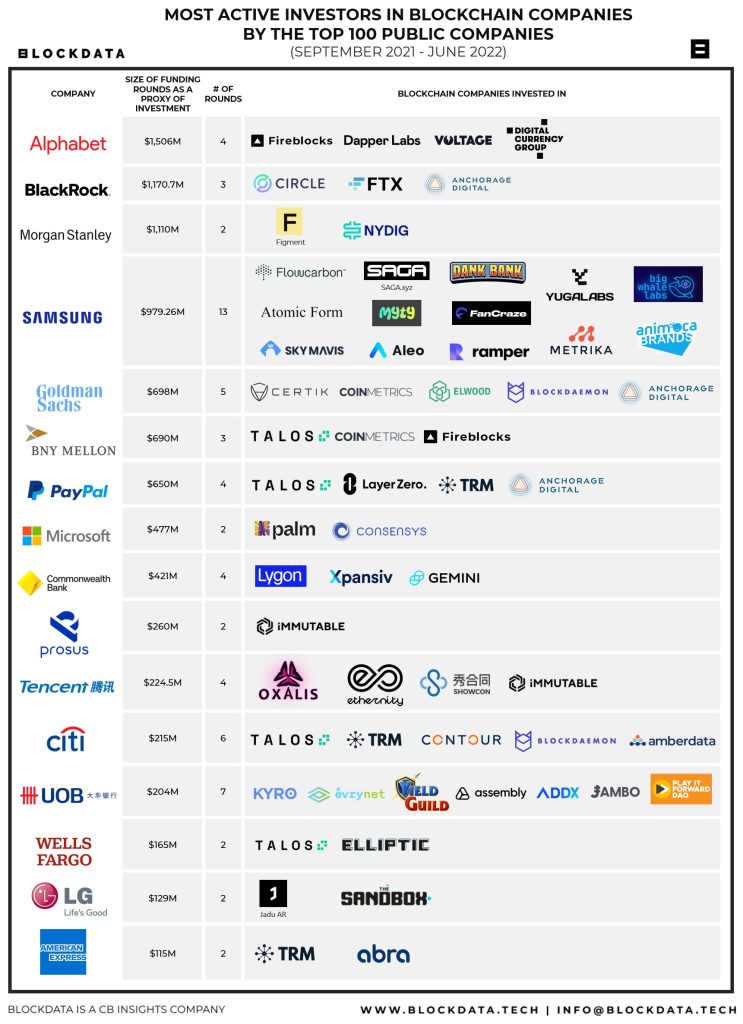
Mark Zuckerberg has announced the launch of Horizon Worlds in France and Spain
The screenshot Mark went with to illustrate the news has received many comments and questions and the feedback was harsh.
Some said the graphics looked like they belonged in a computer game played by the kids in 1997. Others said it looked worse than The Sims and even the Money for Nothing music video launched by legendary Dire Straits on MTV back in 1987.
Mark defended the image with a later post saying the graphics in Horizon are improving very quickly and users just have to be patient.
Facebook has invested over 10 billion dollars to date to support its VR ambitions. For that kind of money, users are expecting their VR graphics to look a little bit more polished.
What we know about Horizon Worlds is that the platform hit a total monthly userbase of 300,000 people this year, 10,000 worlds have been built to date and Meta is currently working on a desktop and mobile version.
AR adoption in sports: the sector is set to reach $100 billion by 2030
As per this AR report by Research and Markets, AR has a bright future in sports.
Here are the report’s key takeaways:
- In 2020 AR software was worth $6bn globally, and by 2030, the AR software market is estimated to reach $100bn;
- Fan engagement will drive AR in broadcasting and on mobile devices;
- Tech sponsorships and partnerships are one of the market’s growth factors: in 2021, telecommunication operators accounted for $420.56M of sports sponsorships deals and IT services companies spent $205.85M;
- Leading sports federations and teams adopting AR: the NFL, NHL, the International Olympic Committee (IOC), and Manchester City Football Club;
- Leading sponsors and vendors supporting AR in sport: Verizon, Sony, Douyin (TikTok), Brainstorm, and Vizrt AR.
HBO Max partnered with Snap to launch AR experiences for ‘House of the Dragon’ premiere
The ‘Game of Thrones’ prequel ‘House of the Dragon’ premiered on August 21, on HBO Max.
In an effort to reach old and new fans aged 18 to 54, the TV channel and streaming service launched a mega marketing campaign valued at $100 million in media spend as per Deadline.
The campaign spanned social media, outdoor, digital, traditional TV spots, promotions on selected distribution partners, live experiences and activations.

Source: Social Media Today
On social media, the campaign rolled out 12 videos on Facebook at 11.1M views and fewer on YouTube with 134.2M views, according to social media analytics firm RelishMix.
On Snap, users were given access to in-app AR experiences: a selfie Lens and Landmarkers Lenses. The selfie lens transforms the user into a fire-breathing dragon and the Landmarker Lenses reveal AR renderings of the show’s dragons over local landmarks all over the globe.
With 10 million viewers for its first episode, ‘House of the Dragon’ premiere is the biggest in HBO’s history so the campaign paid off big time.
Printed books, e-books and now a-books: the future of paper books is AR
The University of Surrey has announced a major breakthrough in its Next Generation Paper (NGP) project: allowing the reader to consume information on the printed paper and screen side by side.
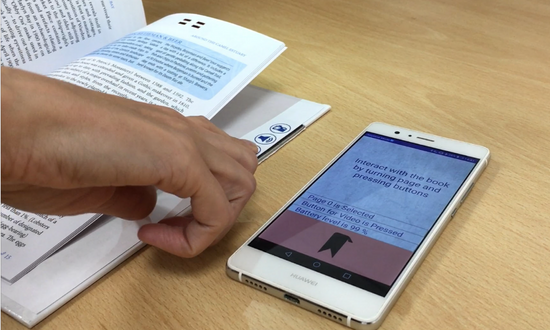
Source: University of Surrey
The a-books (short for augmented books) provide readers with an enhanced reading experience.
The user/reader triggers digital content with a swipe of a finger, which will then be displayed on a nearby device. The a-books are power efficient and are made of pre-printed conductive paper with no wiring visible to the reader.
There are many uses for a-books: user manuals where you swipe your finger and play a short how-to video, fantasy novels, where you get to see the characters, history books where you can play an audio file of one of Churchill’s inspiring speeches and so on.
+6100 professionals have attended BRAND MINDS 2022: What you’ve missed
BRAND MINDS was a fantastic event where business professionals from over 50 countries learned proven frameworks, laughed, had AHA! moments, and connected with each other.
CEOs, investors, startup founders, sales, marketing and advertising experts, business developers and many other professionals in various industries got together and networked to build new connections and business opportunities.
BRAND MINDS is the largest business event in Romania and one of the Top 5 largest business events in Europe.
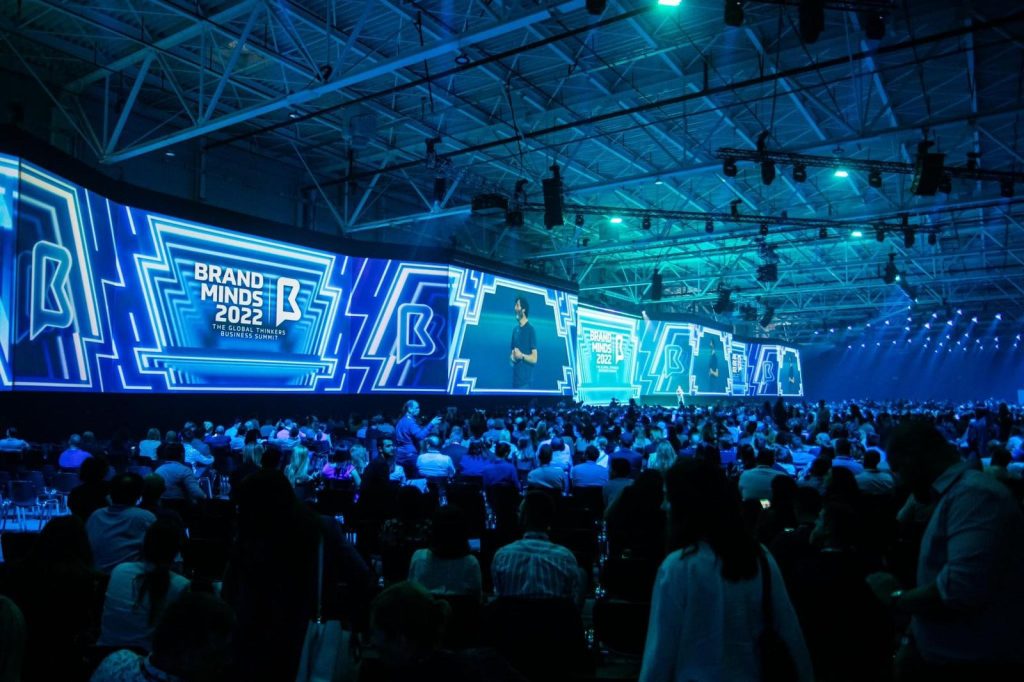
BRAND MINDS 2022: Here’s what you’ve missed
- An amazing immersive in-person experience;
- One of the largest screens in the world, setting a new standard for business events;
- 2 days packed with invaluable insights on Business Scaleup & Strategy, Sales Strategy, Viral Marketing, Team Leadership, Team Performance, Stress Management, Business Innovation, Personal Growth, and Understanding of the consumer’s mind;
- Unique opportunities for high-level networking in a futuristically designed space.
- Interactive & memorable activations from premium partners.
UNIQUE TAKEAWAYS FOR A SUCCESSFUL BUSINESS & CAREER
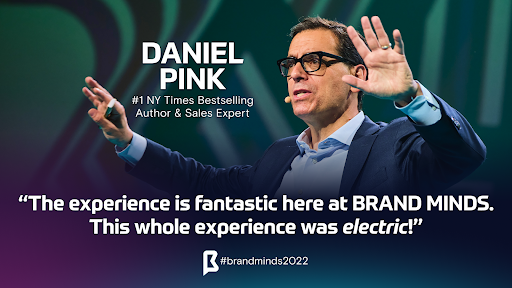
DANIEL PINK – The new rules of selling & influence
- People spend 40% of their time selling even though they don’t work in sales.
- Successful sales professionals learn a new set of ABCs in sales: attunement, buoyancy and clarity. Attunement is perspective-taking: seeing things from another person’s view. Buoyancy is how to stay afloat in a sea of rejection. Clarity is shifting from accessing information to finding what’s relevant and what’s not.
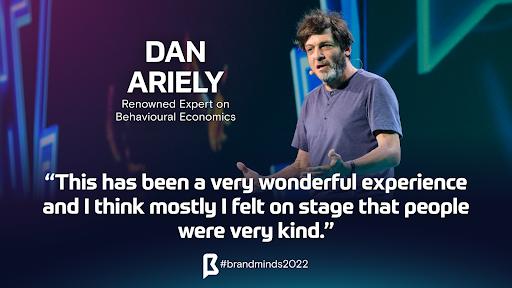
DAN ARIELY – How to change behaviour
- How to eliminate friction: see what kind of effort every little thing takes and reduce it. Also, try to align the easy behaviour with the desired behaviour.
- Add motivation to influence people’s behaviour: more time with the family, money, improved health, and social status.

GABOR MATÉ – The mind/body unity and the stress-disease connection
- People who identify with their jobs are more prone to stress-induced illness. You are not your job.
- Our interpretation of what happens to us is the source of stress, not the situation itself.
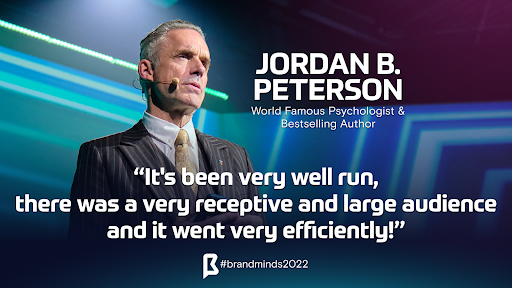
JORDAN B PETERSON – 12 rules for a successful career & life
- Surround yourself with highly competent people and give them autonomy, avoid micromanaging them.
- The most important skill of a leader: summarize what other people say even if you don’t agree with them. You show them attention which is the essential social currency.

ANGELA OGUNTALA – How to rethink your company for the future
- Projection bias, anchoring bias and status-quo bias are toxic to the innovation process.
- Explore the idea of WHAT IF, especially for things that didn’t work out.

MARK MANSON – How to improve your personal leadership
- It’s essential you define the right measure of success.
- Whatever we choose to optimize, we are always giving up on something else, whether we realize it or not.
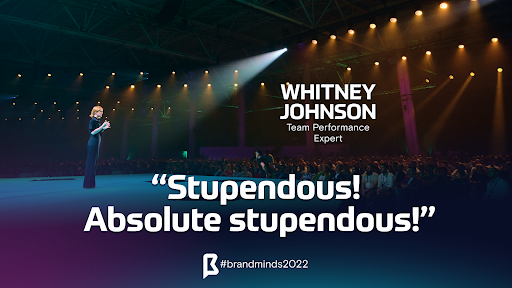
WHITNEY JOHNSON – The best tactics for building an extraordinary team
- The best team is made of 20% employees at the launch point, 60% at the sweet spot and 20% at mastery.
- We are wired to grow. Grow yourself to grow your people and that will grow your company.

GARY VAYNERCHUK – The ultimate strategies to build outstanding businesses
- The biggest opportunity since the internet and social media is the Consumer Blockchain.
- Pair your service subscription with an NFT and you have a new business revenue.
Special thanks go to our supporting partners without whom BRAND MINDS wouldn’t be happening at this scale and last, but not least, we are grateful for each and every person who joined BRAND MINDS 2022 and will take the inspiration forward.
Meet the GLOBAL THINKERS joining BRAND MINDS 2023!
The event will take place on June 2nd & 3rd, 2023, at Romexpo.
2 DAYS left to secure your tickets for a special price and they are available HERE.
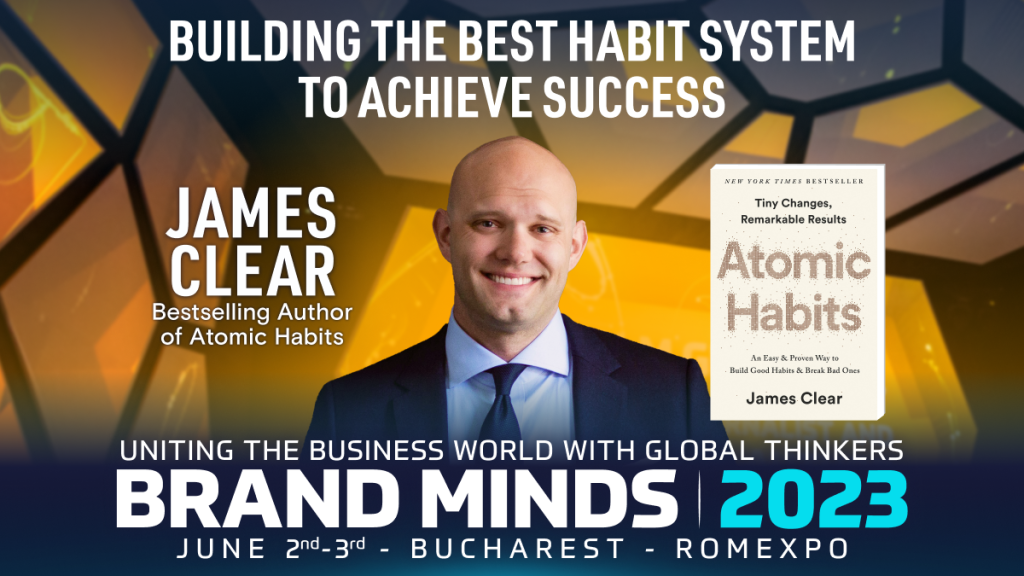
JAMES CLEAR – Bestselling Author of Atomic Habits
Bestselling Author James Clear, one of the world’s leading experts on habit formation, will be speaking at BRAND MINDS 2023.
James Clear is creating successful decision-making frameworks for building continuous improvement. His book, Atomic Habits has reached tremendous fame all around the globe, holding its title of the #1 New York Times Bestselling book for over a year.
He inspires +1.5 million people to achieve great results through his popular 3-2-1 newsletter by sharing remarkable ideas and outstanding concepts.
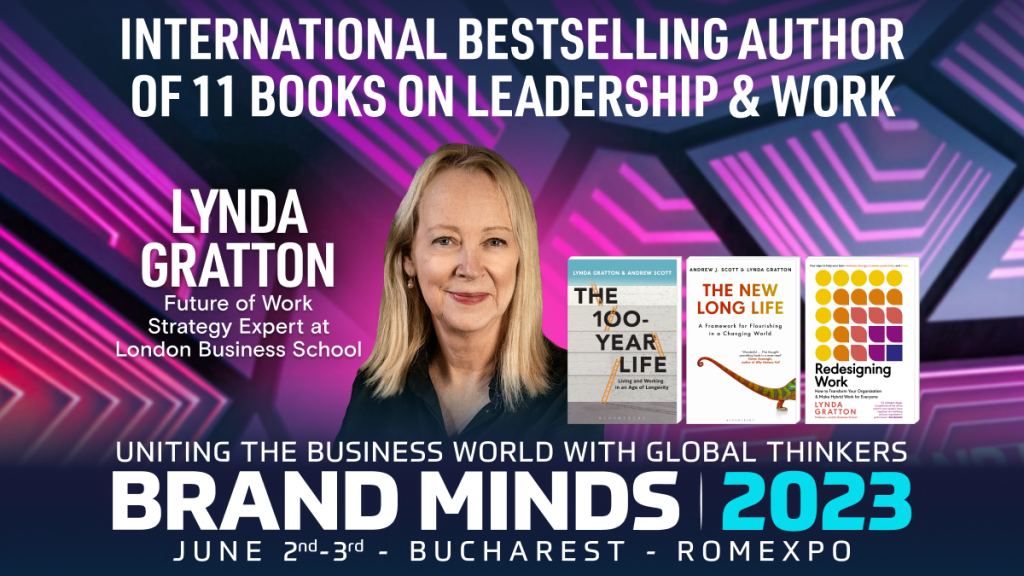
LYNDA GRATTON – Future of Work Strategy Expert @ LONDON BUSINESS SCHOOL
Lynda Gratton is an internationally-respected Professor of Management Practice at the London Business School with an incredible teaching experience of 33 years. She is an award-winning thought leader on the future of work and the role of corporations.
She served on former Japanese Prime Minister Abe’s “Council for Designing 100-Year Life Society” and is an esteemed member of the Council of the World Economic Forum.
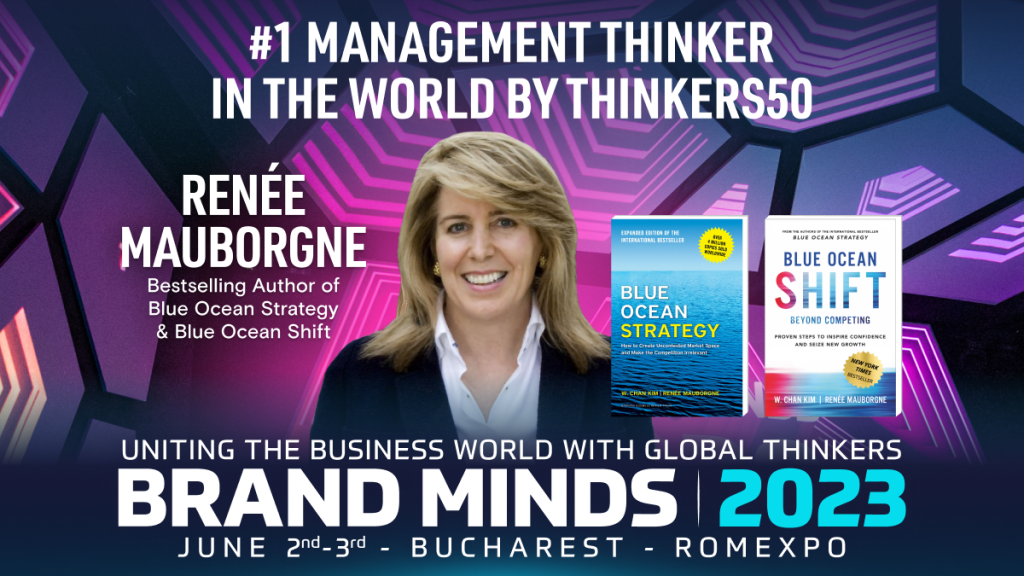
RENÉE MAUBORGNE – Bestselling Author of Blue Ocean Strategy & Blue Ocean Shift
Renée Mauborgne is one of the world’s most famous business strategists. Based on her 10-year study of strategic business moves across 30 industries, her unique strategy teaches leaders how to uncover new markets.
Her book, Blue Ocean Strategy, sold over 4 million copies around the globe and is recognized as one of the most iconic and impactful strategy books ever written. The Financial Times called it “one of the bestselling business books of the century”.
She was specially selected as the Fellow of the World Economic Forum and Davos and was chosen for the Leadership Hall of Fame by Fast Company.
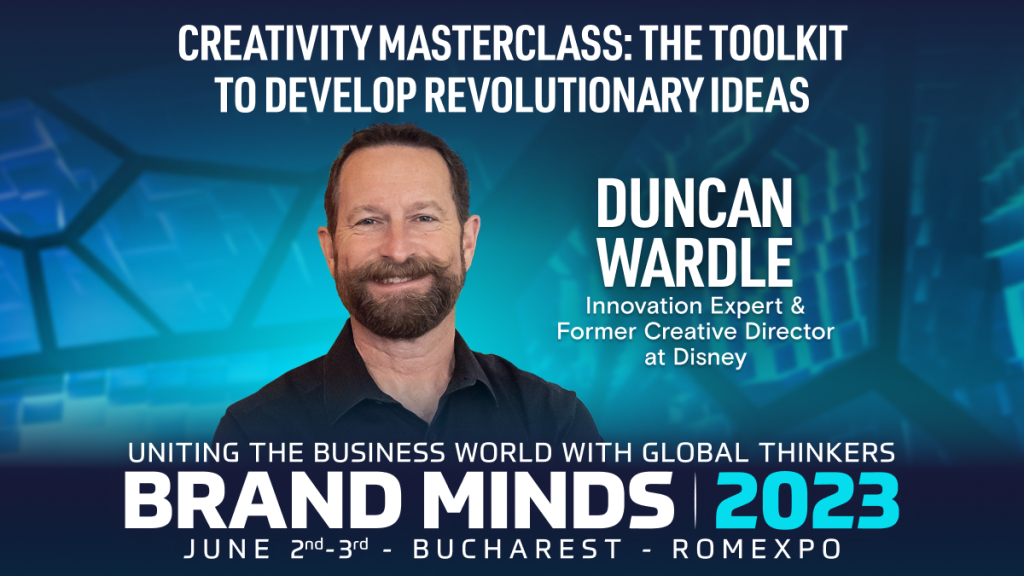
DUNCAN WARDLE – Innovation Expert & Former Creative Director at DISNEY
He has been Head of Innovation and Creativity for 25 years at one of the most beloved companies on the entire globe: The Walt Disney Company.
Duncan Wardle is a renowned expert in developing innovative, magical brands, engaging stories, and creative experiences that drive results.
In recognition of his global and unique approach to design thinking, he received the Duke of Edinburgh Award.
On Day 2 of BRAND MINDS 2023, Duncan Wardle will deliver his premium CREATIVITY MASTERCLASS which helps leaders embed innovation into their team’s DNA by learning THE TOOLKIT TO DEVELOP REVOLUTIONARY IDEAS.
More Global Thinkers are to be announced soon!
Learn more about the secrets of successful business and leadership at www.brandminds.com.
Xclusiverse co-founder Florina Onetiu – In 5 years, people will see metaverses as a part of life
Xclusiverse is a metaverse endorsed by a eCommerce platform, that will aid social interactions among people of the world and business entities, allowing them to connect, and interact while also providing the space to buy digital and physical products on the platform.
In the interview below, Xclusiverse co-founder Florina Onetiu shared with us more about the company, its mission and the future.

Xclusiverse co-founder Florina Onetiu
The first industry to benefit from Xclusiverse is real estate. Why?
We are in an era where a new world is opening for us, and we are grateful to be the builders of a virtual world that will bring value to businesses and users around the globe.
Like building a city, we started by building solid foundations that would provide people with spaces, buildings, and offices in the metaverse and in the real world.
We want to support the real estate industry in achieving its high potential. Through our metaverse, we’ll give the real estate agencies and developers the possibility of the impossible.
We offer them the possibility to maximize their business, have a solid foundation for the growth of their business, build a recognized brand, run a profitable and sustainable business by increasing revenue while limiting expenses and, more importantly, to maintain an excellent relationship with their customers.
What industries will follow real estate?
From mid-July, Xclusiverse will be open to all industries that already see that the future is around the corner.
Once businesses and people will choose those locations, we will open our world to all other industries eager to bring value to the people who will explore this new world.
We are confident that businesses that want to scale globally will respond positively to our invitation to come to Xclusiverse. We are already discussing with some industries such as luxury fashion retailers, software companies, architecture and design, logistics, professional accountant’s associations and more.
What is the main benefit provided by Xclusiverse to its customers?
Think about it: you are a company that plans to gain more market share. You can do this in an old-fashioned way and/or you can access customers from all over the world and be a pioneer in a world that, just like the internet 20 or so years ago, is now beginning!
The main benefit we offer to stakeholders such as companies is limitless opportunities for our growth and rapid expansion as we win the hearts of every creative and internet user. And for users: an immersive social, connection and shopping experience with both physical and digital products.
Xclusiverse is building several spaces inside its platform. What are they and what is their goal?
There will be 3 areas:
Xclusiverse City – a luxury playground for immersive social interaction, play and earn, meet, and greet and other activities;
Xclusiverse Mall – where the shops will sell regular and digital products;
Xclusiverse Club – an area designed for exclusive meetings and offline events.
Name the main 3 pain points that Xclusiverse solves for its customers.
Time
Rich connection
Lack of revenue lines for businesses
The desire for exclusive, empowered communities
What is the brand’s vision for the next 3 years?
Our vision is to build the largest global community of people on blockchain technology through exquisite experiences of virtual interaction, shopping, and real-world meetings.
What will the world look like in 5 years and what role will the Metaverse play in people’s lives?
In 5 years, the world will be even more supported by technology. The Metaverse technology will make it possible to bridge the real and virtual worlds, will break the distance and time issue and will build communities of people that can interact, shop, sell, and promote their business through platforms.
In 5 years, humans will probably be able to reach Mars and all this experience can be followed and lived through metaverses.
In more than 5 years, I believe that people will see metaverses as a part of life, just as they have adopted the internet, touch screen phones or social media. And most likely the metaverses will bring new learning opportunities, social, financial, shopping, jobs and so on.

What is the latest news about Xclusiverse our readers should learn about?
I’m glad you asked! What is important to know is that at Brand Minds we are trying to break a world record!
Because we believe so much in the concept of bridging the worlds, we decided to create a community of people who would take the first step towards the new virtual worlds by building an avatar within the physical event Brand Minds.
Then what’s important to know is that Xclusiverse is up and running for members – real estate companies for now, and starting October, users will be able to experience and enjoy the first features of Xclusiverse!
We can’t wait, we are very excited!
Last Tickets Available for BRAND MINDS
BRAND MINDS 2022 is your unmissable opportunity to see global leaders live, on stage, and discover brilliant ideas that shape the future of business.
Prices go up on June 9th, at midnight, so hurry up, and grab your tickets before the event is sold out! Last tickets are available at www.brandminds.com
Over 5500 professionals and industry leaders are expected to join this year’s edition from all over Europe to access the ultimate insights and tactics to develop their teams and business strategy.

6 reasons why you should join BRAND MINDS:
- Meet world-famous business thinkers
- Experience the team-building of the year
- Network with top leaders in your industry
- Reconnect with all your partners in a memorable business event
- Boost your professional brand with the BRAND MINDS certificate
- Benefit from an A-to-Z business education on:
- Business Scaleup & Strategy
- Sales Strategy
- Viral Marketing
- Team Leadership
- Team Performance
- Stress Management
- Business Innovation
- Personal Growth
- Understanding the consumer’s mind
THE BEST GLOBAL BUSINESS THINKERS
will be rocking the stage at BRAND MINDS 2022
Registration starts on June 17th, at 7:00 AM
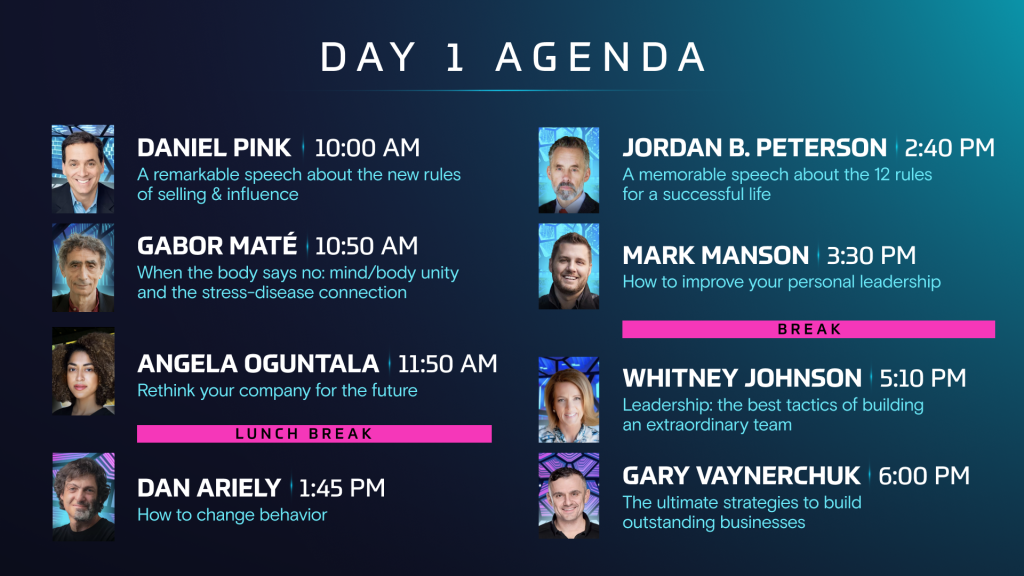
DAY 2 ACCESS is only available for Business & First Class Ticket Holders.
If your ticket is not covering DAY 2, you can UPGRADE it here.
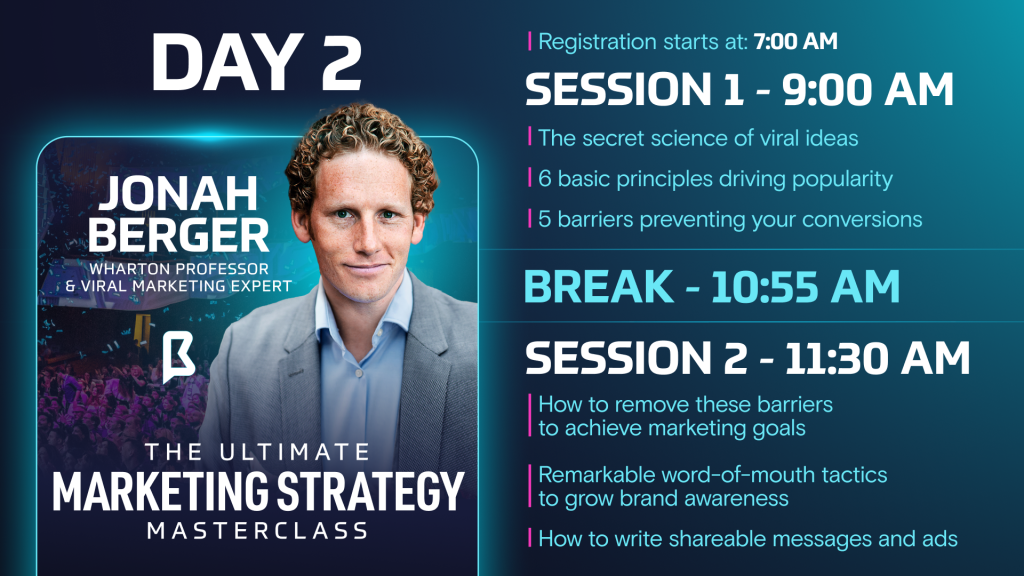
Are you one of the following professionals?
Then BRAND MINDS is for you!
1.Business Developers looking to deliver more value to clients by leveraging human behaviour trends;
2. Organizational Leaders looking to reduce work-related stress and improve professional efficiency;
3. Entrepreneurs, Top executives and CEOs looking for verified lessons on business scale-up & strategy;
4. Coaches, Trainers and Psychologists looking for outstanding personal growth tactics;
5. Human Resources Managers looking to discover talent growth opportunities for employees;
6. Sales Specialists and Negotiation Experts looking for new techniques to close more sales;
7. IT leaders and Tech Experts looking to gain a competitive advantage through innovation;
8. Marketing, Branding and Advertising Experts looking to achieve business goals by creating viral marketing campaigns;
9. Team Leaders looking to understand the challenges impacting their leadership.
Learn with your team how to build a winning strategy for your company at
BRAND MINDS 2022!
Last tickets are available on www.brandminds.com
+20 Augmented Reality (AR) global market and user statistics for 2022
+20 Augmented Reality (AR) global market and user statistics for 2022
1.The global augmented reality market size was $4.16 billion in 2020. The market is projected to grow from $6.12 billion in 2021 to $97.76 billion in 2028 at a CAGR of 48.6% in the 2021-2028 period (source).
2. The biggest brands investing in AR: Apple, Google, Nvidia.

Source: Motley Fool
3. In 2022, there will be an estimated 1.1 billion mobile AR users worldwide (Statista).
4. There will be more than 100 million AR users in US before the end of 2025.
5. AR adoption is tracking with the mobile usage boom – by 2025, nearly 75% of the global population and almost all smartphone users will be frequent AR users.
6. 65% of AR consumers around the world and across generations use AR to have fun.
7. The majority are discovering AR through social/communications apps.
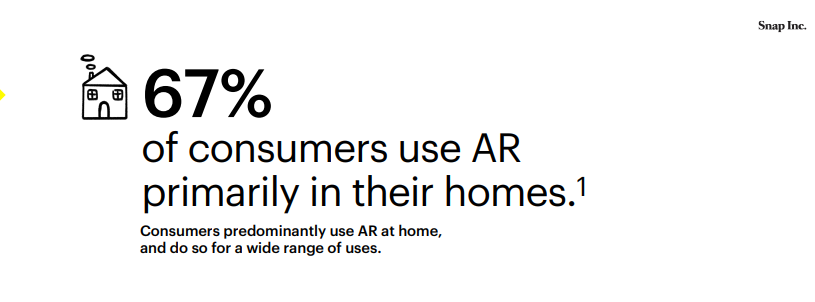
Source: Snap
8. Interacting with products that have AR experiences leads to a 94% higher conversion rate.
9. Gen Z / Millennials are both 71% more likely to use AR all the time vs. older generations.
10. Older generations are nearly 20% more likely to view AR primarily as practical.
11. There are 100 million consumers shopping with AR online and in-stores.
12. AR-related patents in the US grew more than 3x over the last 10 years.
13. 5G will accelerate AR technology adoption with benefits like increased download speeds and accessibility.
14. People who frequently use AR with their family and friends are 50% more likely to pay attention to a brand.
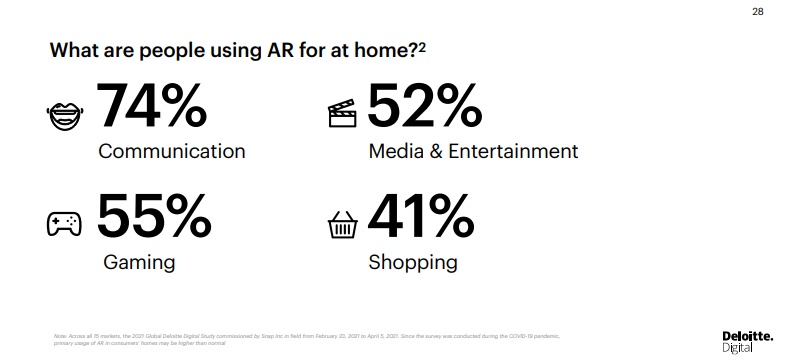
Source: Snap
15. Brands are 41% more likely to be considered if they have a branded AR experience.
16. Over half of people want to use AR technology to assess products, allowing for a risk-free try-before-you-buy experience.
17. Nearly 3 in 4 consumers say they’re willing to pay more for a product that promises the total transparency that AR can provide.
18. AR-guided purchases led to a 25% decrease in returns.
19. Social is driving AR adoption. People want to share their favourite Brand’s AR experiences.
20. AR interactions drive conversion. Interacting with products that have AR experiences leads to a 94% higher conversion rate as individuals can better assess them and feel connected with brands.
21. Consumers take over 4.5 billion AR photos and /or videos daily.
22. 74% of consumers believe that AR will be even more important in their lives in the next 5 years.
23. Over 50% of AR developers have under a year of experience.

Source: Snap
Drivers accelerating the adoption of AR
- Consumers are becoming creators
- Desire to increase utility
- Increased mobile usage through COVID-19
- Keeping things fun
- The availability of smartphones with cameras
Barriers slowing the adoption of AR
- Lack of content
- Industry-wide limited enablement & engagement with the developer/creator community
- Need for a frictionless experience
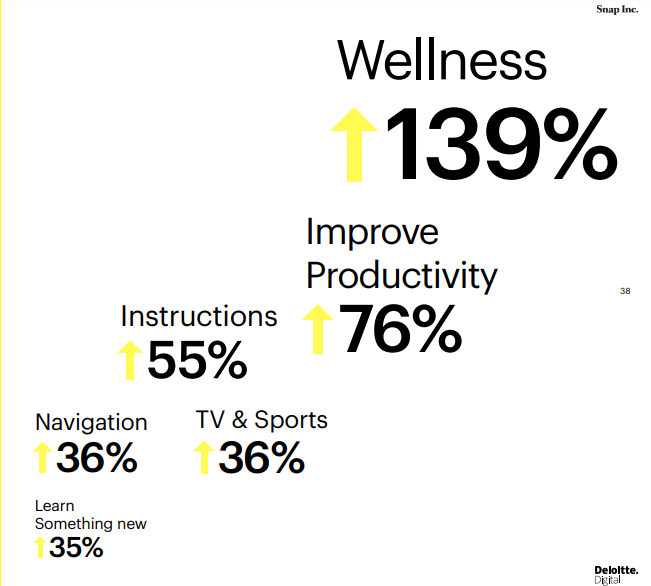
Source: Snap
Don’t know what AR is?
Here’s a great example from Lenovo, our event partner:
Congratulations, @Lenovo for winning 3 Webby Awards with the creative & innovative MLKonMLK #AR campaign! via @TheWebbyAwards https://t.co/tjS9hW8Nx6
How it was made: https://t.co/R8wjF9Gt9Y #AugmentedReality pic.twitter.com/pZ6Ix0AKlZ— BRAND MINDS (@brand_minds) May 3, 2022
Source: SNAP Consumer AR Research Global Report
21 Leadership lessons from Jeff Bezos, Robert Iger and Whitney Johnson
ROBERT IGER, former Disney CEO – 9 leadership lessons
Robert (Bob) Iger is the foreman Chairman and CEO of The Walt Disney Company, one of the world’s largest and most admired media and entertainment companies.
Since becoming CEO in 2005, he oversaw the acquisitions of Pixar (2006), Marvel (2009), Lucasfilm (2012) and 21st Century Fox (2019).

Robert Iger with George Lucas (source: Robert Iger Twitter account)
In 2016 Disney expanded its international footprint by opening its first theme park and resort in Mainland China, Shanghai Disney Resort.
He also took the company to the next level using technology by creating an ambitious direct-to-consumer strategy that features the company’s various streaming services, including Disney+, which debuts on November 12.
His book, The Ride of a Lifetime: Lessons learned from 15 years as CEO of The Walt Disney Company launched on September 23.
Here are 9 leadership lessons that he shared in a LinkedIn article where he tells the story of the Lucasfilm acquisition and the making of the first Disney produced Star Wars film.
9 leadership lessons from Bob Iger:
- Talk to your team members to make sure everyone is on the same page and fully understand the stakes;
- Share the burden of what it means to be responsible with your team members;
- Communicate to your team members that you are their partner and not just a CEO putting pressure on them to deliver results;
- Be a resource and a collaborator, make them feel that they could call you at any moment to discuss any problem they might wrestling with;
- Remind your team that you believe in them and that there are no better minds to run your company’s projects;
- If you can’t make the deadline, it’s ok. Don’t rush to deliver your project on time even if this means taking a short-term hit to your bottom line. Sacrificing quality is never an option;
- Decide wisely when it’s worth engaging in any public discourse and when it’s not;
- When you run negotiations, let your partners know clearly about where you stand while allowing yourself to show empathy if the situation calls for it;
- A successful deal is a deal where you build trust with your partners and suppliers.
You have to try to recognize that when the stakes of a project are very high, there’s not much to be gained from putting additional pressure on the people working on it.
Robert Iger
JEFF BEZOS, former Amazon CEO – 6 leadership lessons
Amazon founder Jeff Bezos stepped down as the company’s CEO in 2021. He founded the eCommerce retailer 27 years ago in a garage when it “was only an idea” and people were asking him “What’s the internet?”.
Leveraging the power of the internet and thanks to his vision of what makes a successful company, today Amazon is the world’s largest online retailer of consumer products and a leader in the cloud computing segment.
According to Statista, in 2021, the online retail platform Amazon reported a net income of $33.36 billion, up 56% from a $21.3 billion net income in the previous year.

Source: Jeff Bezos Twitter account
Leadership lessons from Jeff Bezos:
- Move quickly to solidify and extend your current position
In 1997, with big tech companies like Microsoft and AOL expressing interest in online commerce, Bezos saw a window of opportunity.“Our goal is to move quickly to solidify and extend our current position while we begin to pursue online commerce opportunities in other areas. We see substantial opportunity in the large markets we are targeting”, he writes in his 1997 shareholder letter. I remind you that, at the time, Amazon was still selling books. - Set out to delight your customers
Jeff believes complaining customers are a company’s most valuable resource for growth. They reveal blind spots that employees or managers could not otherwise identify giving the business the opportunity to improve and develop. Amazon’s focus on customer obsession is one of its underlining factors for success. - Make bold investment decisions
At the heart of Amazon’s investments is the customer. Every investment that Amazon makes is to further improve customer satisfaction and experience by developing systems, infrastructure and service. - Your employees must think like an owner
Jeff acknowledged early on that hiring the right people was paramount if Amazon was to be successful and achieve its objectives. “Setting the bar high in our approach to hiring has been, and will continue to be, the single most important element of Amazon.com’s success.”The retailer behemoth compensates its employees in Amazon stock than cash because becoming stockholders changes their mindset. - Embrace external trends
Businesses that adapt to the latest technological trends and customer behaviour changes evolve and survive. Businesses that resist change, don’t survive. His advice to every company founder is to acknowledge powerful external trends like AI and machine learning and embrace them quickly. - Make high-quality decisions fast
Large organizations like Amazon have many things going for them with one downside: they are slow at making decisions. Jeff didn’t allow this to happen to Amazon.He created a system of making high-quality decisions fast which relies entirely on the Day 1 mindset. Day 1 companies are startups, nimble and agile, bursting with vitality. Day 2 companies are already heading for the end. Amazon is a Day 1 company.
WHITNEY JOHNSON, CEO of Disruption Advisors – 6 leadership lessons
Whitney Johnson is a world-leading expert on developing high-growth teams and one of the leading business thinkers in the world as per Thinkers50.
With +20 years of research, consulting & coaching, Whitney Johnson helps leaders to acquire the necessary skills for leading teams with confidence and a strategic approach.

Leadership lessons from Whitney Johnson:
1.Take your business to the next level by putting the power of disruptive innovation to work.
“When you are driven by discovery, you take a step forward, gather feedback and adapt.”
2. Change your business strategy as often as necessary.
“70% of all successful new businesses end up with a strategy other than the one they initially pursued.”
3. Hire leaders whose higher goals align with the goals and objectives of your business.
“Before hiring anyone in your team, check to see if their why intersects with the why of the organization.”
4. Always be looking to develop the talent in your business.
“If you develop talent, there is absolutely no condition in which your company actually loses.”
5. Employees are motivated by more than pay raises, bonuses and other extrinsic rewards.
“When we are no longer getting an emotional reward from our career, we may actually end up doing our job poorly.”
6. Encourage your employees to disrupt themselves.
“Make disruption safe. Make it routine. Make it a human resources strategy.”
We are thrilled to have Whitney Johnson on the stage at BRAND MINDS 2022, where she’ll deliver a speech about The best tactics for building an extraordinary team.
